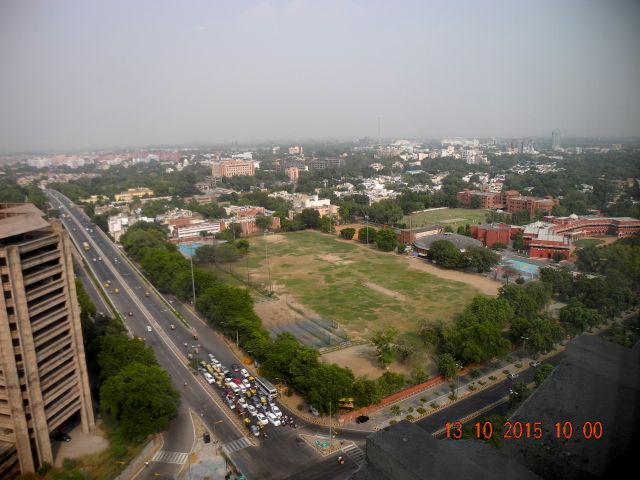
View from our bedroom window.
The view above is looking north
east from the 20th. floor of our first hotel, the Hans on Barakhamba
Road where we eventually arrived mid-afternoon on Tuesday 13th. after an
overnight flight from Heathrow and a lengthy line at immigration.
Highlights were watching the cricket at the rather nicely appointed
school playing field, enjoying looking down on the black kites wheeling
around the derelict building to the left and watching the traffic build
up, all the times on the photos are wrong, this is actually 5.30 in the
morning and already the smog has started to gather.
WEDNESDAY OCTOBER 14th.
The World Monuments Fund produces
some very informative and attractive leaflets about all the Delhi
monuments in PDF format
which can accessed for each site by clicking on the WMF logo

which can accessed for each site by clicking on the WMF logo

WEDNESDAY OCTOBER 14th.
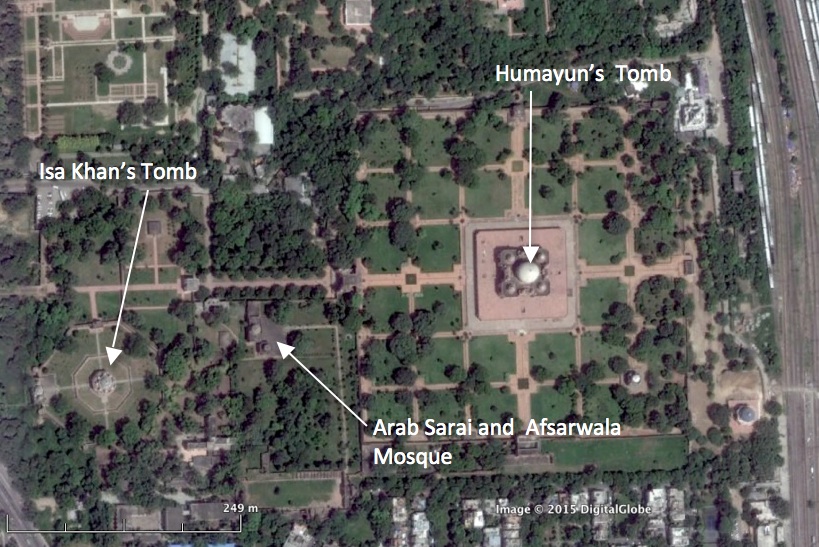
On Wednesday we had arranged through a mutual acquaintance (thanks Parshu) to have a couple of cars plus drivers to see some sites and we began at the newly restored tomb of the second Mughal emperor Humayun. This is now a world heritage site and after paying the special foreigner's admission fee of 250 rupees we found ourselves in a well kept collection of walled gardens. Off to our right was the octagonal enclosure and tomb of Isa Kahn, one of the emperor's generals with an attached mosque and a little further along and through a couple of gates, was the Arab Sarai originally constructed as accommodation for builders working on site, and a further mosque, the Afsarwala. Entry through a final gate lead into the magnificent precinct of the emperor's tomb set in a charbagh or 'quartered garden' with a strictly geometric layout and running water in shallow channels and rectangular pools.
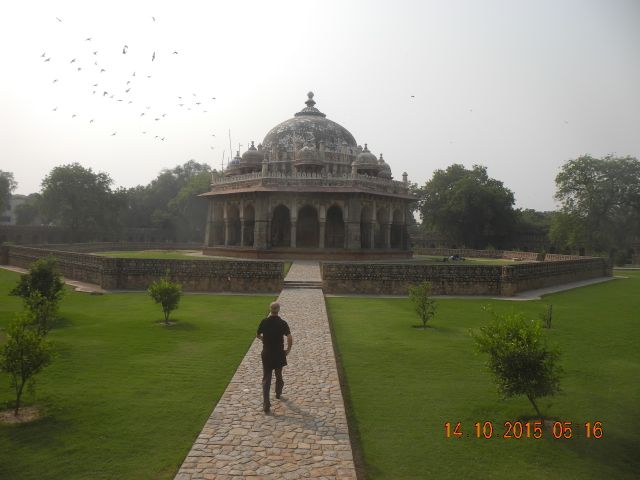
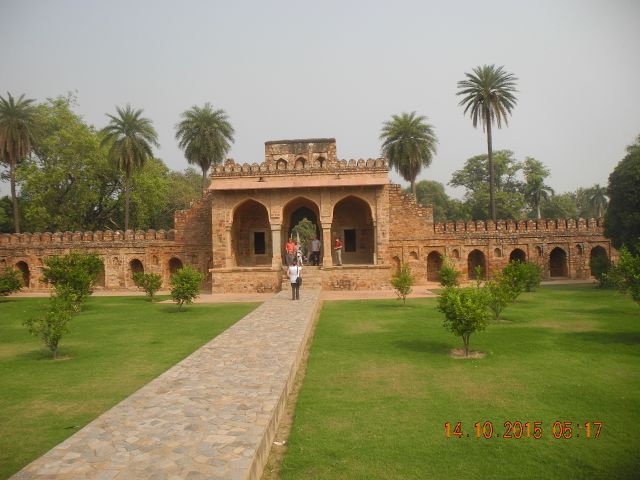
Isa Kahn's Tomb,1547, looking south and the entry gate to the complex looking north.
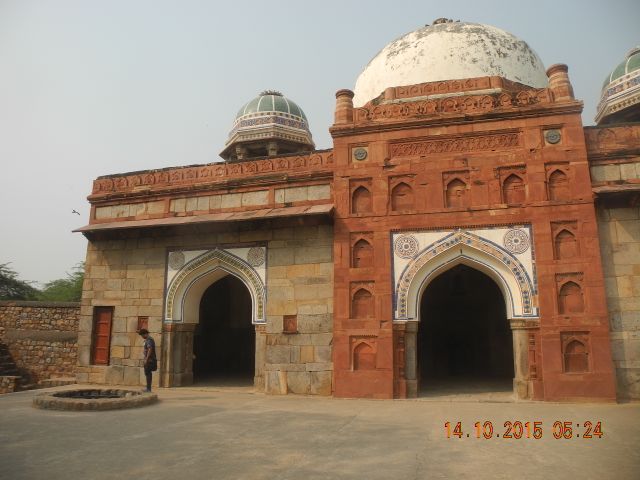
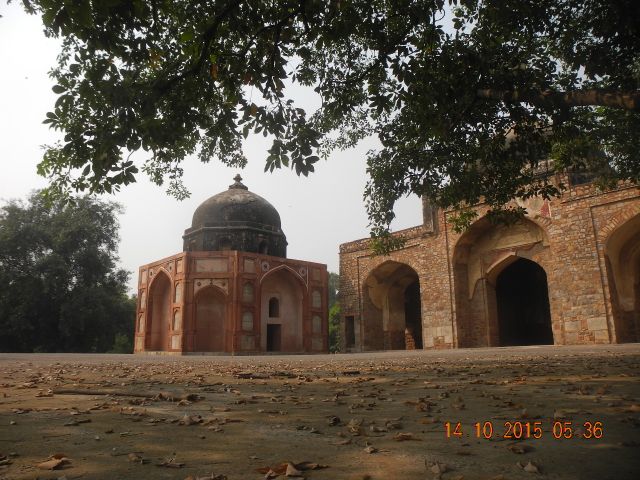
The mosque attached to Isa Khan's Tomb looking east and the Afsarwala Mosque and unknown tomb from the north east.
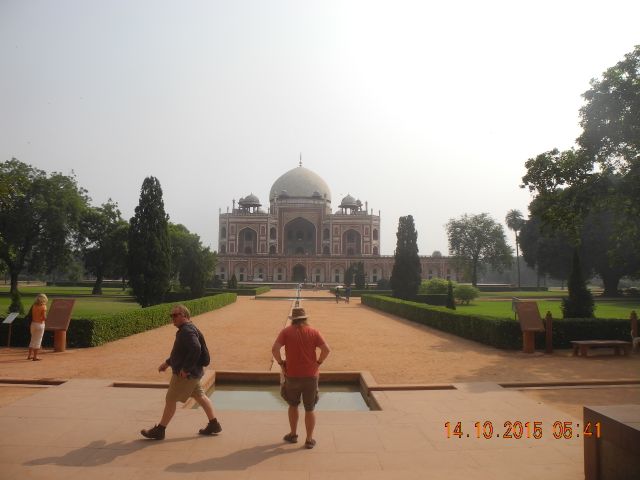
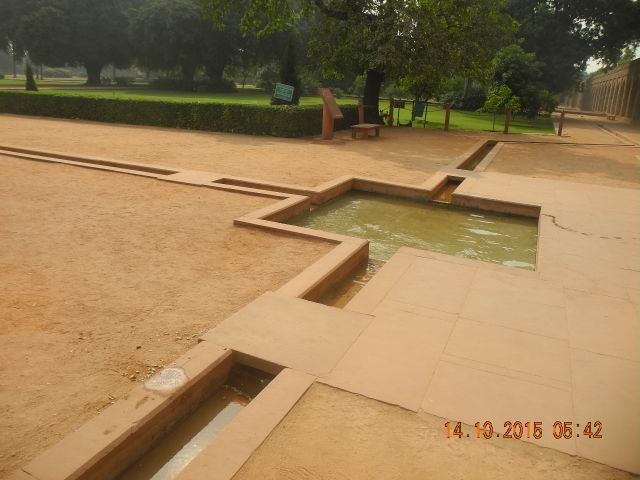
Humayun's Tomb started in 1556 looking east plus detail of the water channels just inside the west gate looking south.
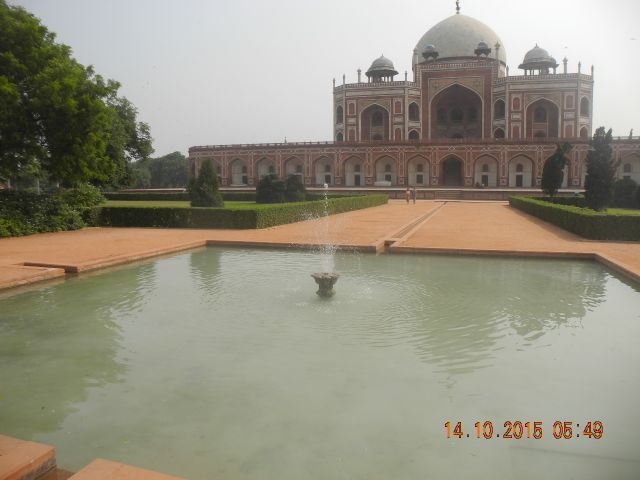
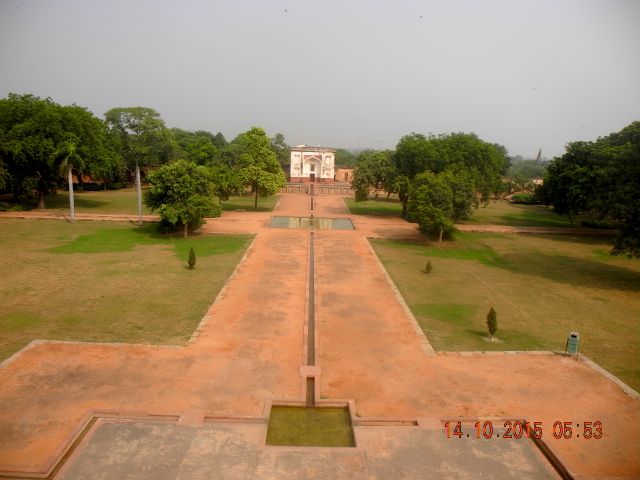
Square pool plus fountain to the west of Humayun's Tomb looking east and view towards northern pavilion from tomb platform.
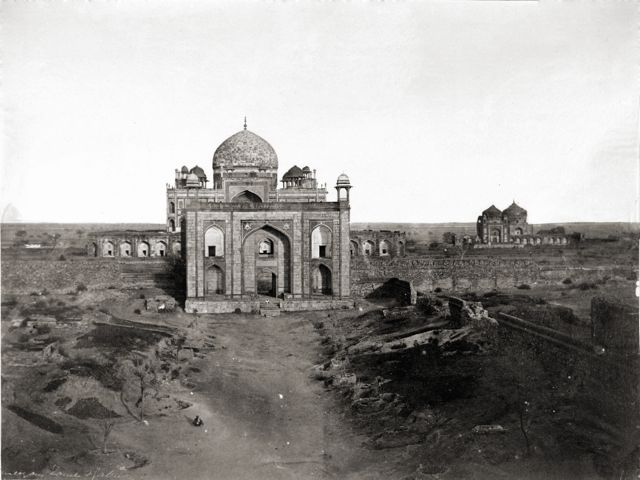
This photograph looking east from 1858 of the gateway with tomb beyond gives some idea of the restoration that has taken place

Humayun's Tomb
Our second stop was
the Purana Qila ( Old Fort )
an impressive fortification which was the
citadel of the sixth city founded in 1533. Entering though the west
gateway we spent a
short time in the small but attractively cool site museum which
contains relics from earlier occupation on the site dating back
prehistoric times. We then cut across the grass to pass by the first
of the step wells or baoli
that we were to see. This one was not especially interesting although it
did descend some 89 steps to the water level. The well lay alongside
the path that lead to the Sher Mandal,
an attractive two storey pavilion possibly originally built as an
observatory in 1541 before being converted to a library by Humayun in
1555. Legend has it that he fell to his death here whilst hurrying down
the steps to answer the call to prayer. Close by and a little to the
south west lay the remains of a bath or hammam
with some interesting terracotta pipes and a possible settling tank,
unfortunately there was no access to the interior so it was impossible
to see some of the additional plumbing mentioned in the literature. Our final stop was the well preserved Qila-e-Kohna Masjid, this mosque was erected by Sher Shan in 1542.
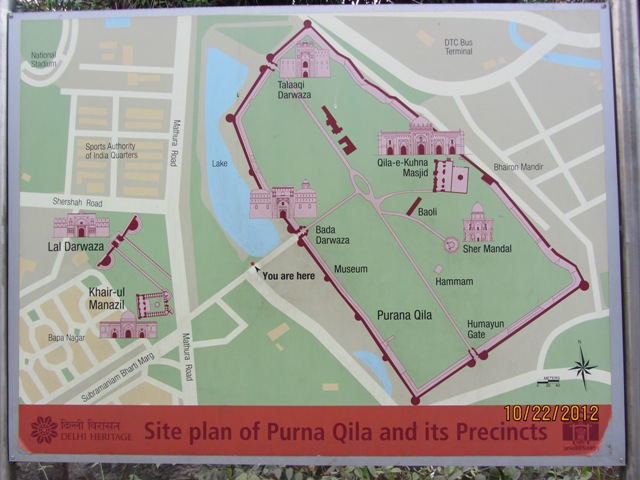
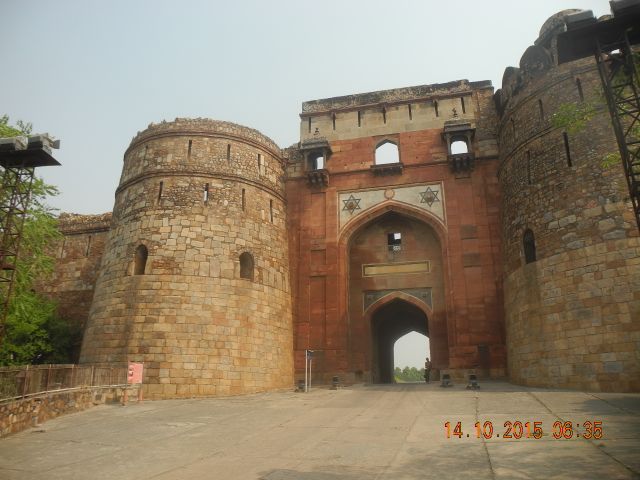
Site plan near the ticket office and the West Gate from the east.
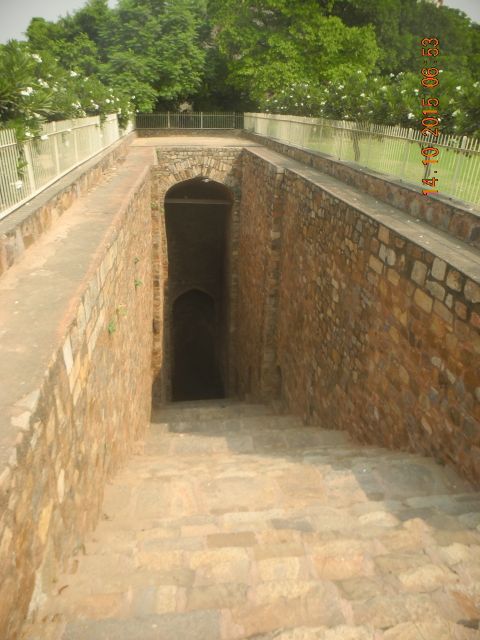
The 89 steps, well looking east.
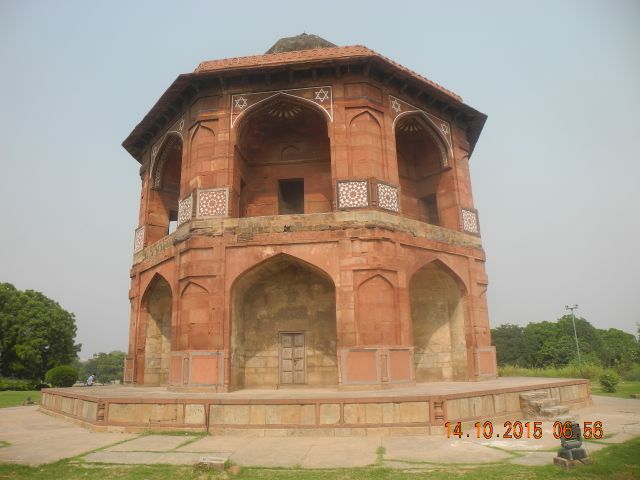
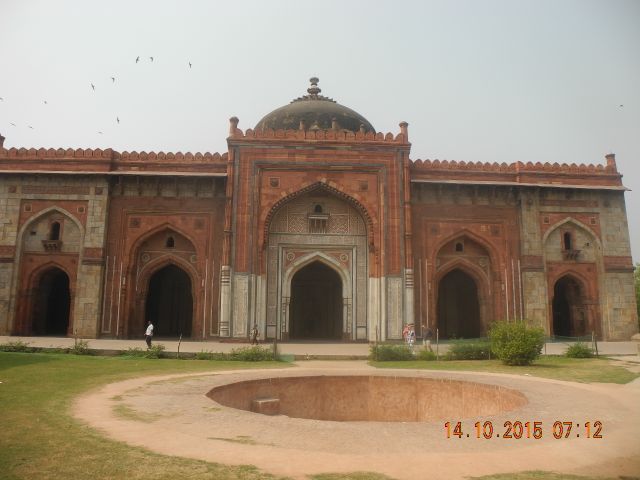
The Sher Mandal looking north east. The Qila-e-Kohna Masjid looking south west, the circular pool in the foreground has been heavily restored.
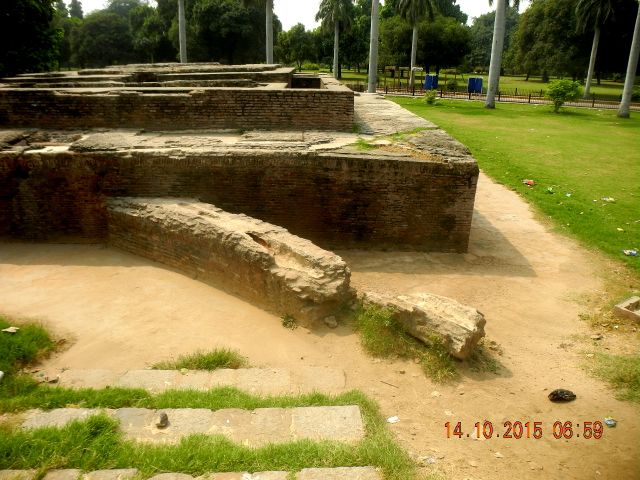

The Hammam, terracotta piping, looks to be draining away from... this small rectangular tank. Both views looking west.

Purana Qila
Parshu had
carefully selected a lunchtime venue for us but our drivers had other
plans and we ended up at a rather poky place with toilets down the road
and no beer called the Hot Chimney. I later discovered that this is
used by a number of taxi drivers for dumping unsuspecting tourists but
the food was fine and cheap and some of the chaps bought beer from just
down the road. You can find it at 68-69, Khanna Market, Lodhi Colony, New Delhi should you be interested.
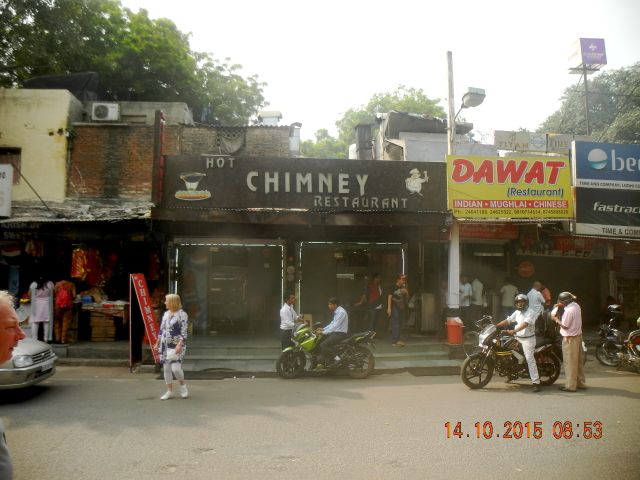
The Hot Chimney, view looking... well not sure really.
Suitably refreshed it was on to another world heritage site, the Qutb Minar down the road in
southern Delhi near the village of Mehrauli. By now the schools were
chucking out and busy roads became busier and then some. Once at our
destination we pulled in to the car park and purchased our tickets
amongst thronging crowds mainly of families plus children. The first
two sites had been comparatively tranquil but here all was bustle. The
complex features one huge minaret the Qutb Minar,
built in 1202 along with adjoining mosque to celebrate the victory of
one Qutb-ud-Din Aibak's and as such the earliest Muslim monument in
Delhi. Much of the material used in the work on the mosque was recycled
from a number of Jain temples in the area which were demolished to make
way for the complex. This makes spotting the odd carved remnant from the
earlier temples quite an interesting pass time but also leads to some
intemperate comments on Trip adviser (of all places) from Hindu
nationalists who see it as a general affront and the site ripe for
redevelopment. One consequence of adopting world heritage status is
that disabled access has to be guaranteed which is a good thing but it
takes care, skill and attention to insert and then maintain the
requisite ramps and handrails to a good standard without them becoming
too intrusive, more work needed on this. Other highlights include an
inscribed iron column,
probably of the fourth century and miraculously rustless and my
personal favourite, the first story of an abandoned attempt to build a
truly colossal minaret, the Alai Minar.
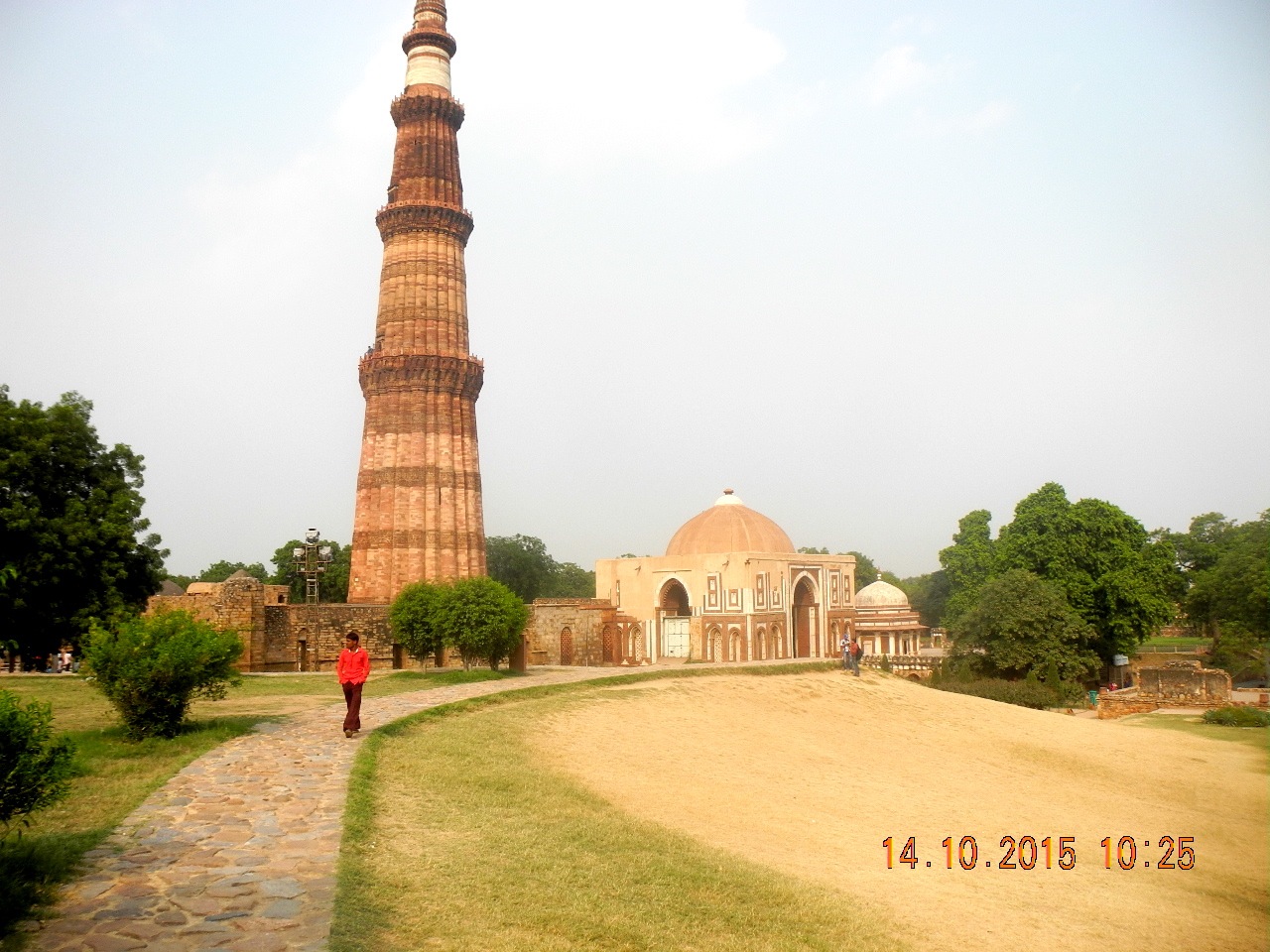
View looking north east across the complex with the Qutb Minar, the Alai Darwaza, early 14th. century and the Tomb of Iman Zamin, early 16th. century
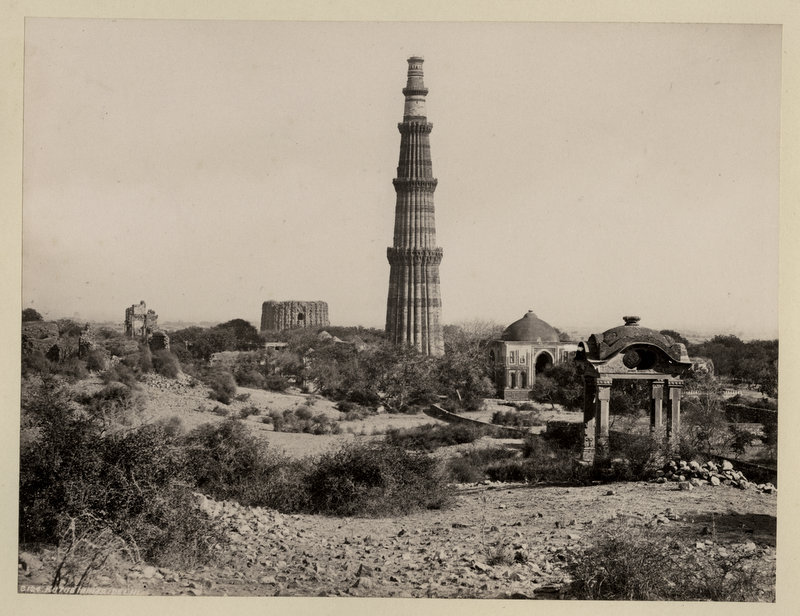
And here's how it looked in the 1880s
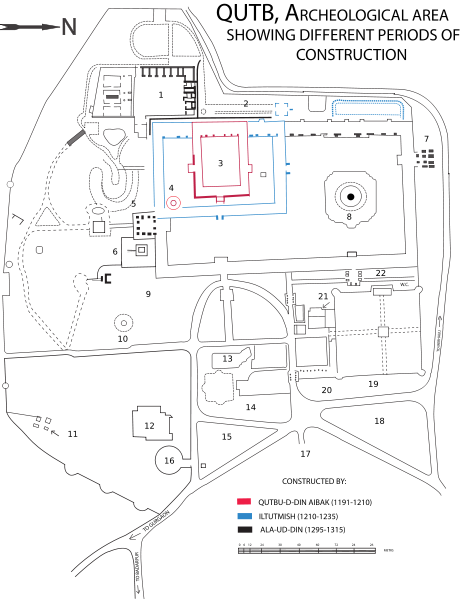 |
1) Alauddin Khalji's Tomb and medresse 2) Tomb of Iltutmish 3) Iron Pillar 4) Qutb Minar. The rectangular blue structure encompassing the Iron pillar and Qutb Minar is the Quwwat-ul-Islam mosque. 5) Alai Darwaza 6) Tomb of Iman Zamin 7) Gateway 8) Alai Minar 9) Gateway 10) Major Smith's Cupola 11) Chaumukha Gate 12) Canteen 13) Rest house 14) Cycle stand 15) Car park 16) Garhgaj 17) Office 18) Lawn 19) Car park 20) Main gate 21) Mosque 22) Gateway |
Found this plan on-line but without credits so not sure where it originated.
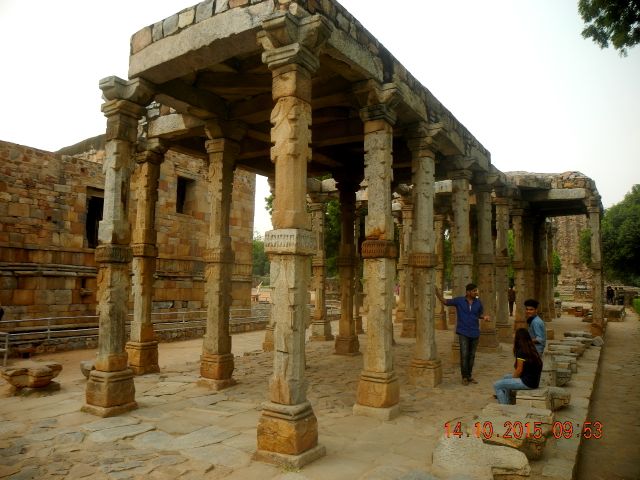
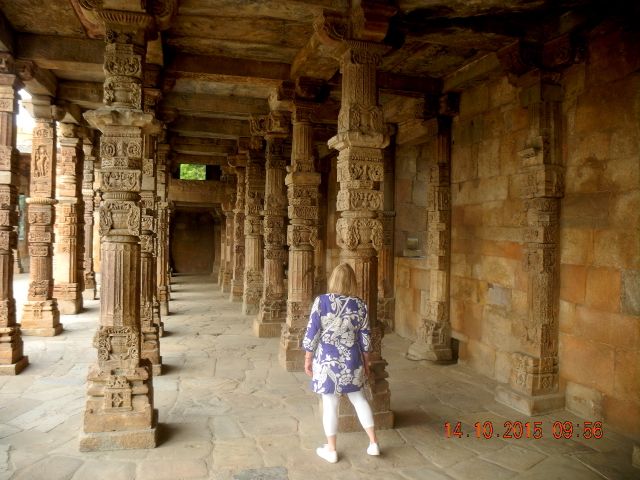
Outer cloister of the Quwwat-ul-Islam Masjid looking north west and the inner cloister looking north
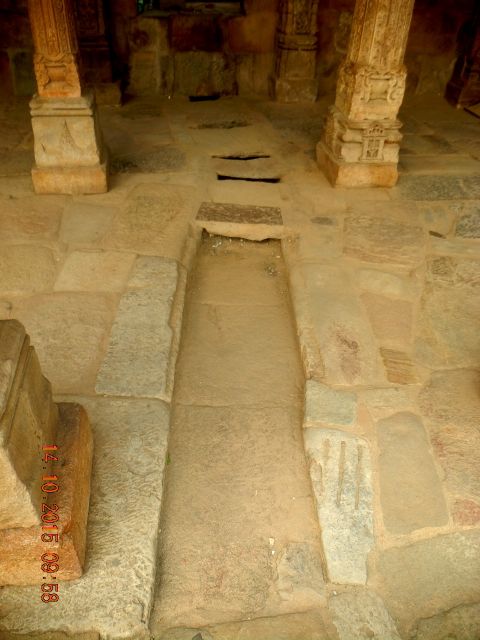
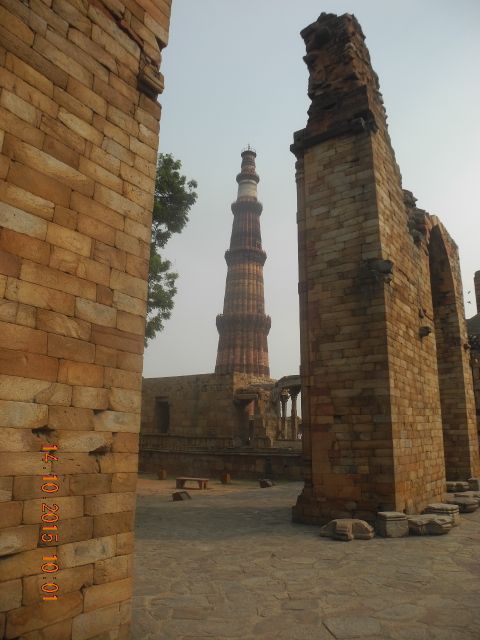
Drain from the courtyard of the mosque looking north. The west end of the mosque with the Qutb Minar looking south east.
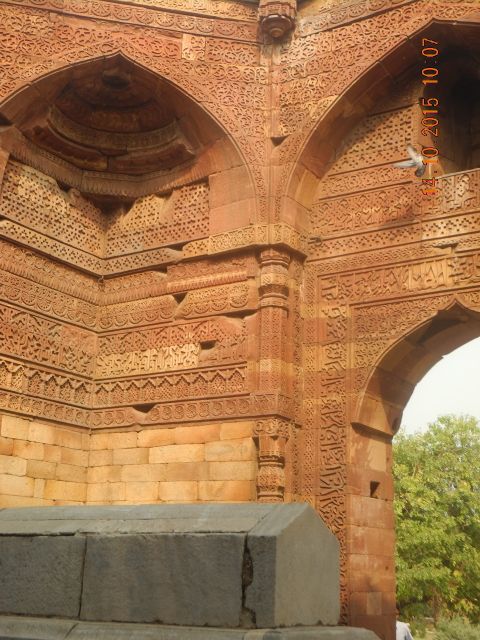
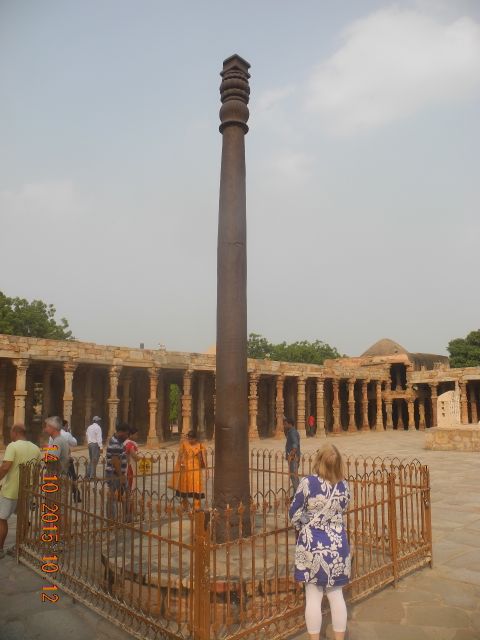
The Tomb of Shamsuddin Iltutmish 1235, interior looking north east. The Iron Column from the south west.
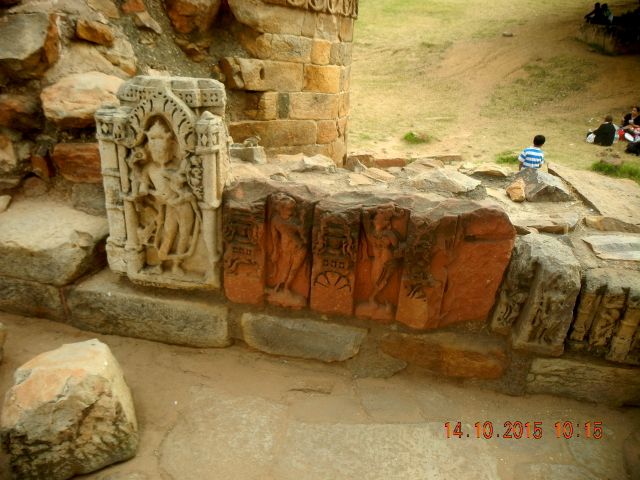
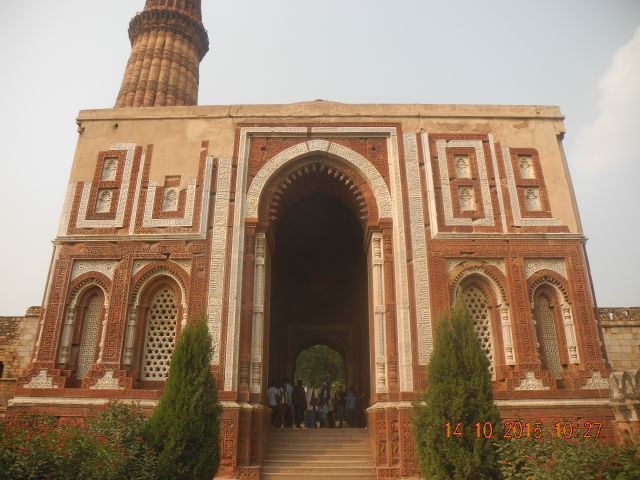
Assorted recycled Jain sculptures on the south side of the mosque. The Alai Darwaza looking north.

The unfinished Alai Minar, abandoned in 1316, should have been twice the height of the Qutb Minar!

Qutb Minar Complex
By now we were
beginning to feel the pace and there was some debate as to whether we
should take on the huge Mehrauli Archaeology Park next door, well why
not, still the entrance took some finding but our drivers were well up
to the challenge and ended up driving us in past assorted overgrown
ruins to a car park next to the Mosque and Tomb of the poet and
traveler Jamali Kamali, an attractive little complex constructed in
1528 and as we arrived a shout went up from somewhere and a custodian
appeared who for a small consideration opened the gate to the courtyard
alongside the mosque where the brightly painted (at least on the
inside) tomb was situated. I was very keen to see the step well Rajaon Ki Baoli
and our drivers worked hard to obtain us directions so we set off,
'five minutes down the road' and five minutes it was and when we got
there it was most impressive and another guard was there to show us
round. On the other side of the lane was another mosque / tomb complex,
this one built in 1506 which is probably the date of the well too.
There were some picturesque and frolicsome goats around who got into a
confrontation with a pack of dogs which was a little alarming as we
were in the middle. The goats came off best and my advice to future
visitors is carry a big stick. We had had enough by this point and
although the park contained many more important remains the general
lack of maintenance, the litter, the squatters and the dogs
persuaded us to quit.
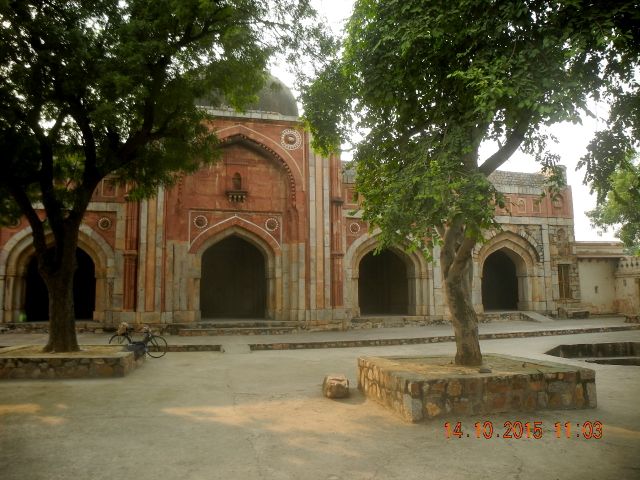
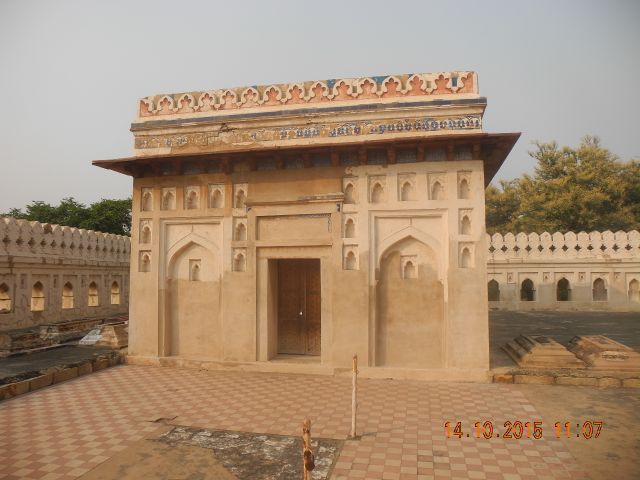
Mosque, looking west and Tomb, looking north, of the poet and traveler Jamali Kamali

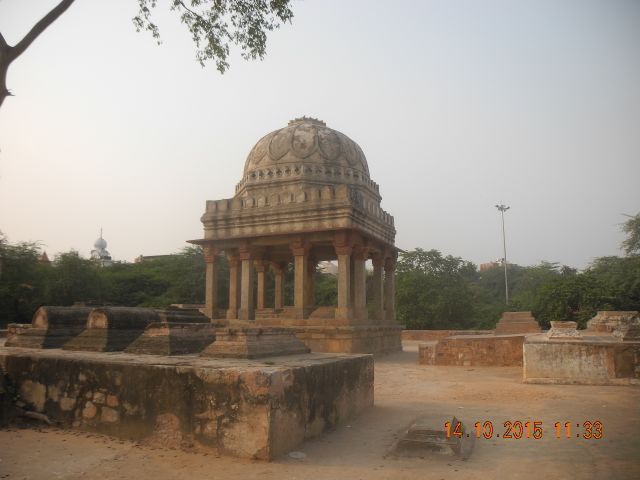
Rajaon Ki Baoli view looking south and adjacent tomb looking north.
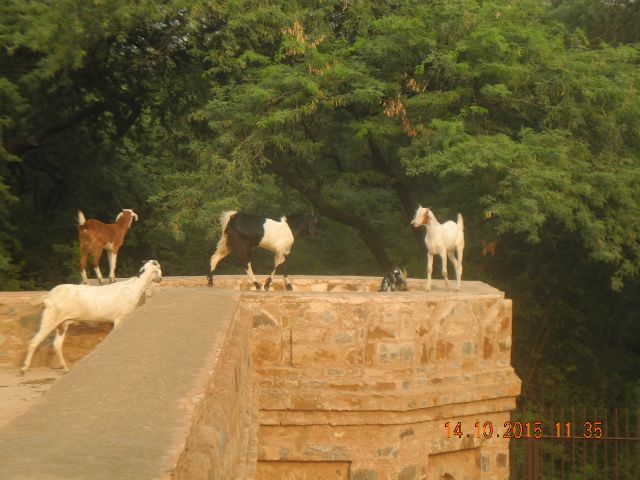
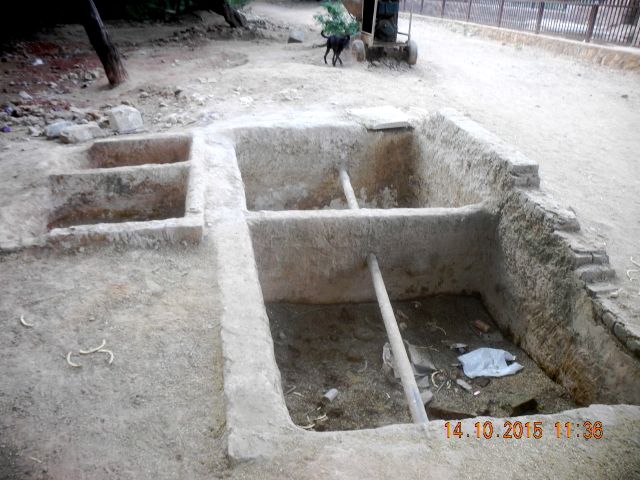
Frolics with goats, before the dogs arrived and former washing tanks placed neatly between the two monuments, view looking west.
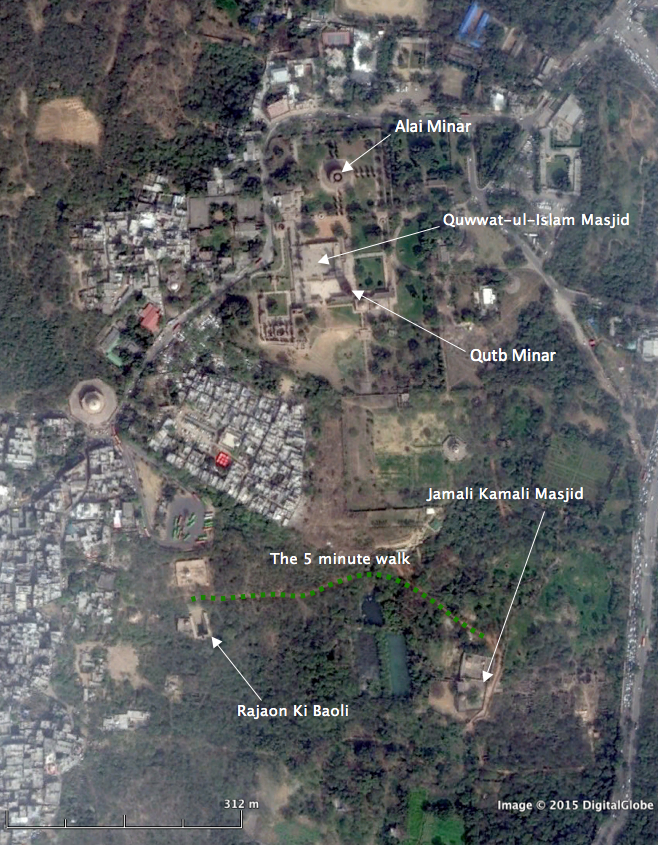

Mehrauli Archaeology Park
In the evening
we had our second experience of hole in the wall dining at the Anand
Restaurant 15/96, Schindi House, Connaught Place, New Delhi, found in
the Rough Guide and approached cautiously along a wet and rutted lane.
Once inside the place had all the ambiance of an old tyre warehouse but
the food was very good.
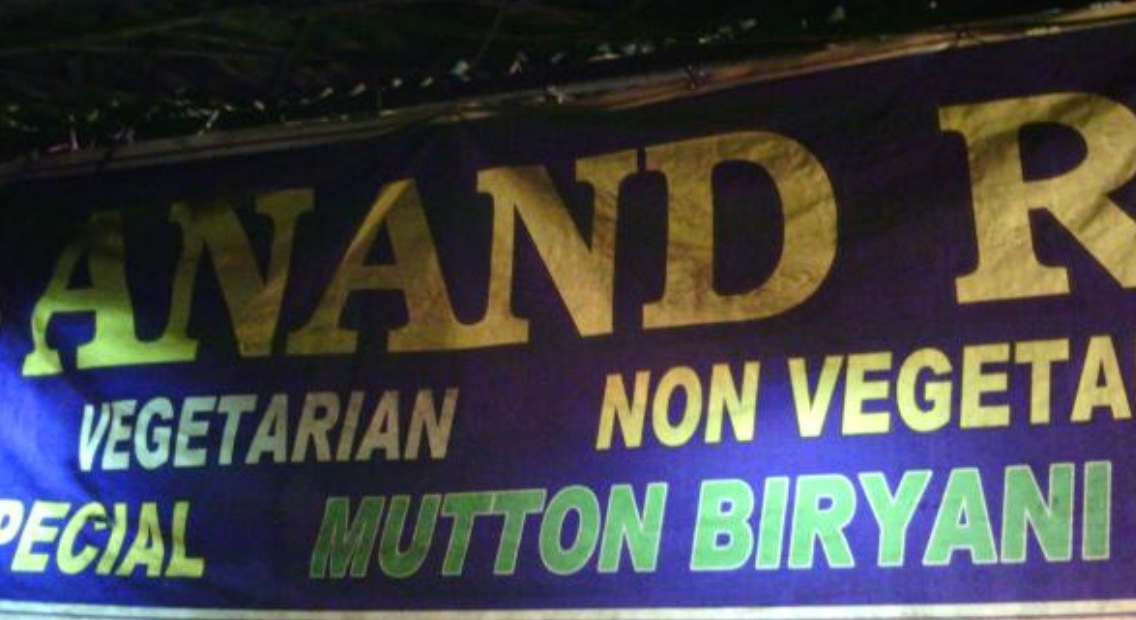
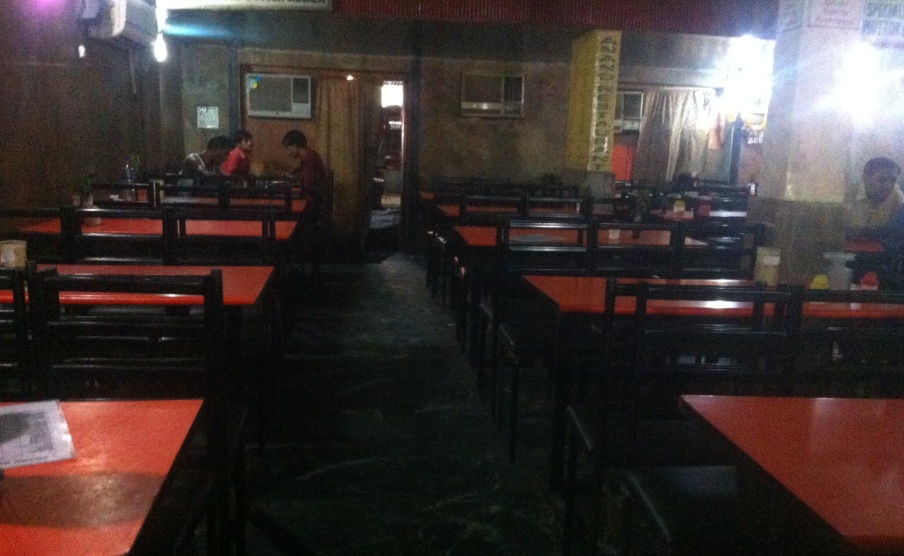
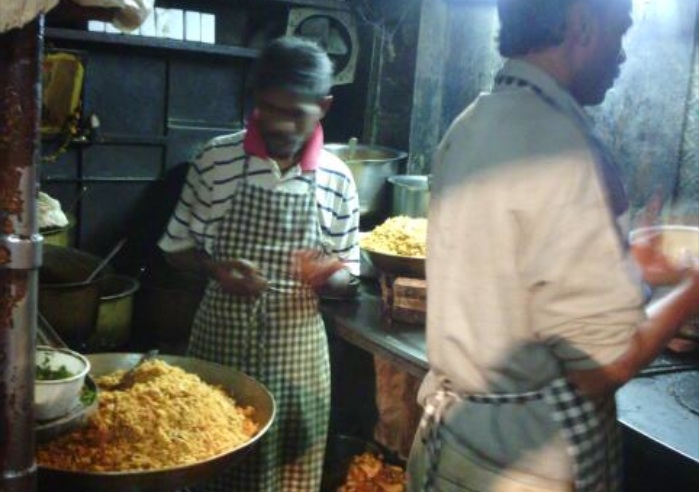
THURSDAY OCTOBER 15th.
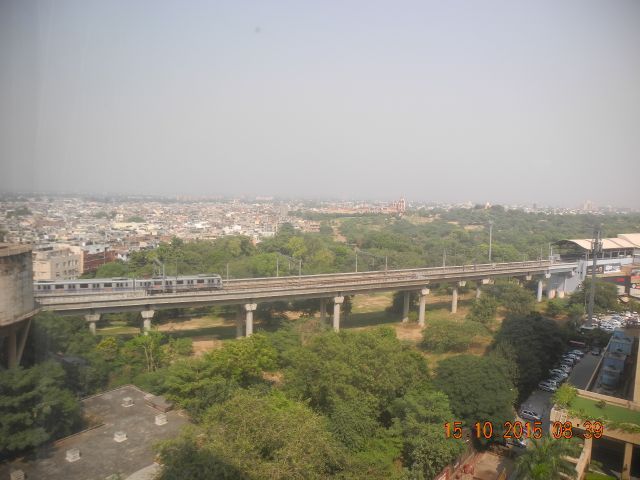
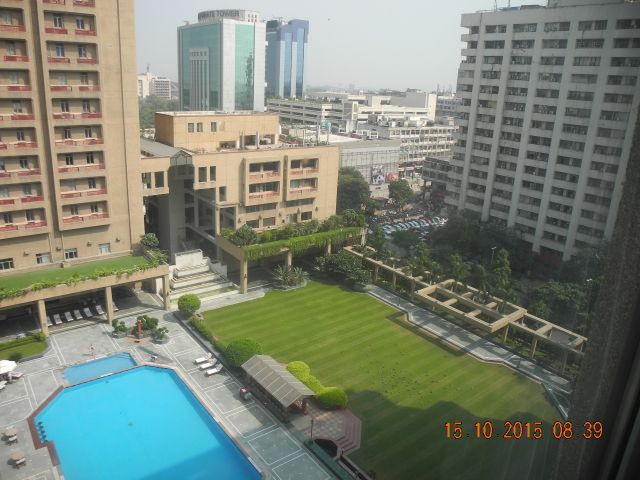
Views from our room at the Eros: looking east across the metro and down into the gardens. The whole complex was semi-fortified with guards at all the gates to insulate us from the teeming street life and poverty below.
Didn't work though, the fellows went out and found a bar.
The initial plan had been to take the metro in to Old Delhi and the Red Fort but we had been instructed by the ICCR to stand by our bags and await imminent collection which we did in the expectation that some kind of welcome or other event had been laid on which required our attendance. We waited and waited and when eventually we were collected and spirited away to the Eros International Hotel in Nehru Place... nothing. We were checked into this luxurious establishment by smart and attentive staff, found our rooms, had an excellent buffet lunch plus expensive beer but still no contact so we decided to take ourselves off on another visit. In a convoy of three taxis we headed south along the Ma Anandamayee Marg towards Tughlakabad and its famous fortified city remains. The road was a modern highway but was lined with construction debris which never seems get cleared away and Indian men relieving themselves, about one every 250 metres all the way along. Once at the fort our drivers were very attentive and after we purchased our tickets they shepherded us across an impossibly busy road to see first the fortified tomb of the city's founder Ghiyas-ud-Din Tughluq. His city was more or less abandoned immediately after his death in 1324 but the remnants are impressive. The tomb stood on an island in a huge lake which lay south of the town and joined to it by a causeway which one walks along to reach the tomb. The lake is long gone and the causeway breached, of course, by the main road which we had to cross back again.... how about a footbridge chaps? On the other side a custodian preceded us with a big stick to drive off the monkeys as we climbed the ramp up to the south gate. Turning left we walked along past the scattered ruins of the palace quarter to another step well and then retraced our steps and continued the climb up to the adjacent citadel. All hugely atmospheric as the sun started to set and cast a red glow over everything through the haze of pollution. We were accompanied by a very determined old man who tried to offer us a guided tour but as we seemed to know more than he did it was rather pointless. He seemed rather offended when at the end I offered him my notes, perhaps he thought I was selling them. On the way back, as is traditional our drivers offered us the opportunity to go shopping but we declined.
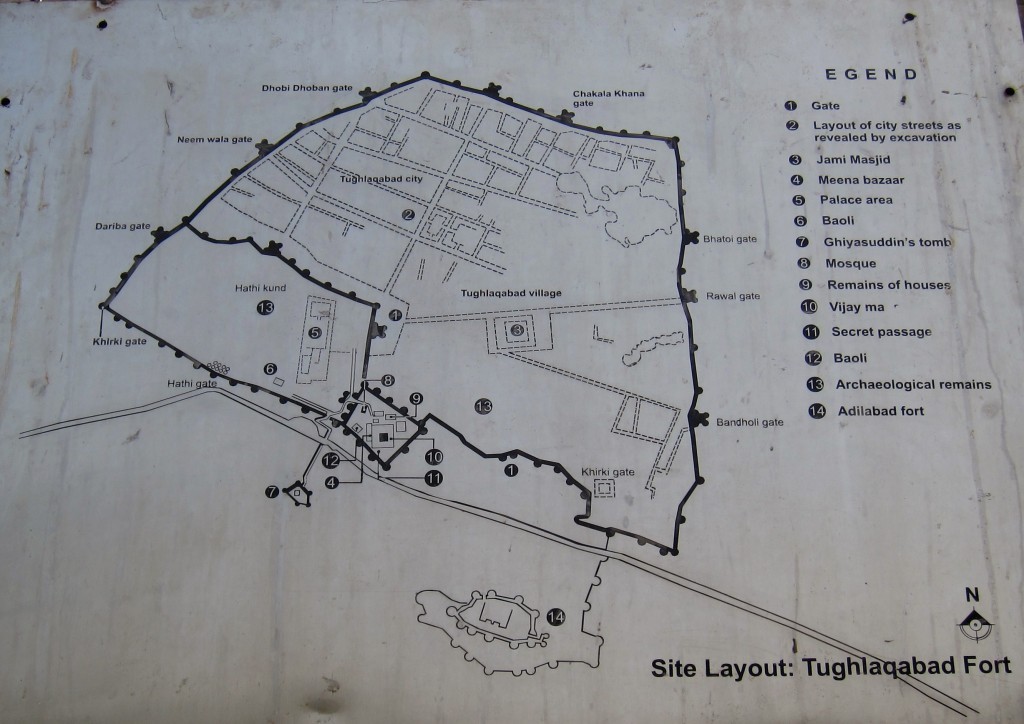
The on-site sit plan, unfortunately there is no scale, the whole complex is around 2.5 kilometres east to west
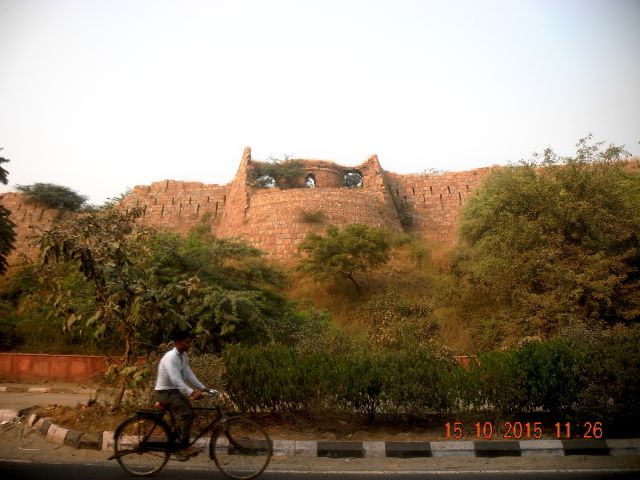

View of the city wall looking north, we are still a couple of kilometres from the ticket office, the site is huge. Ticket office and portion of causeway looking north east plus litter.
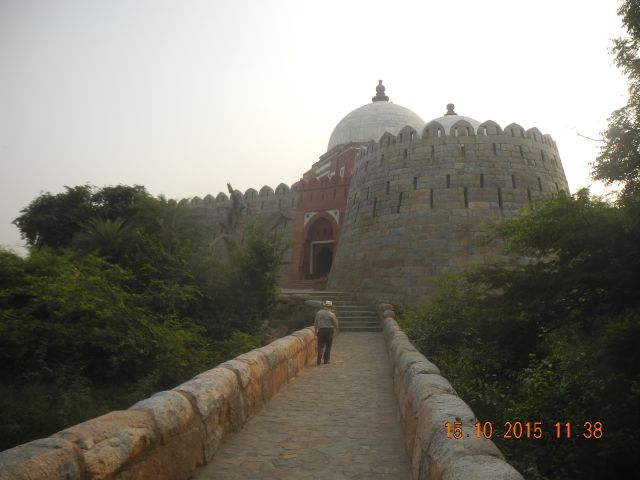
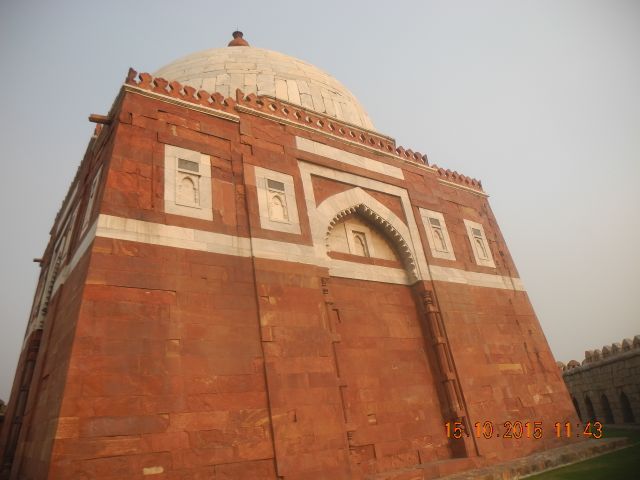
The fortified enclosure looking south and the tomb looking north.
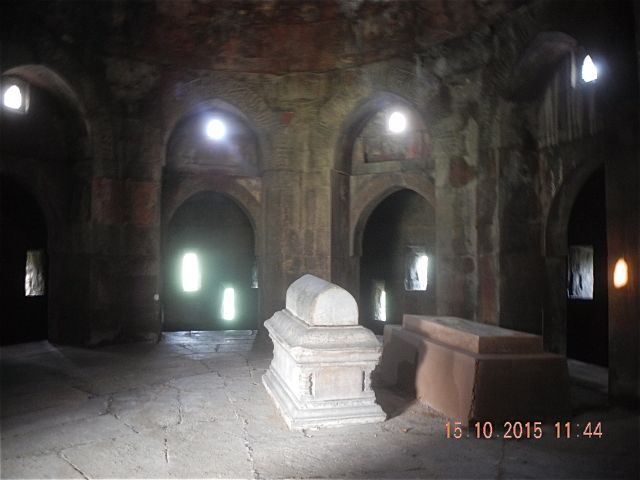
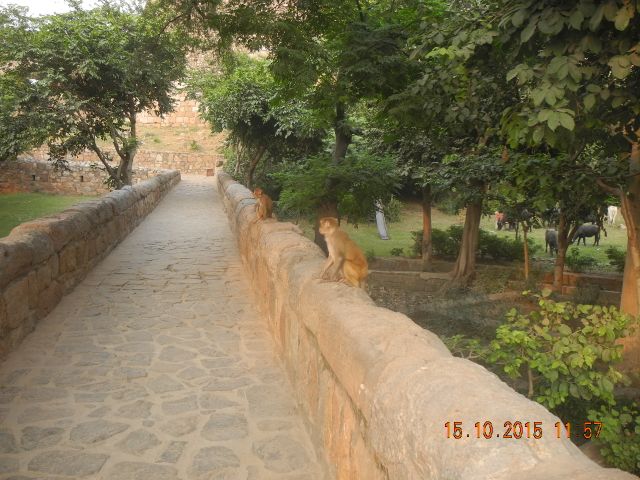
Inside the east bastion the prime minister Jafar Khan's tomb. Back on the causeway to the fort, monkeys wait for...
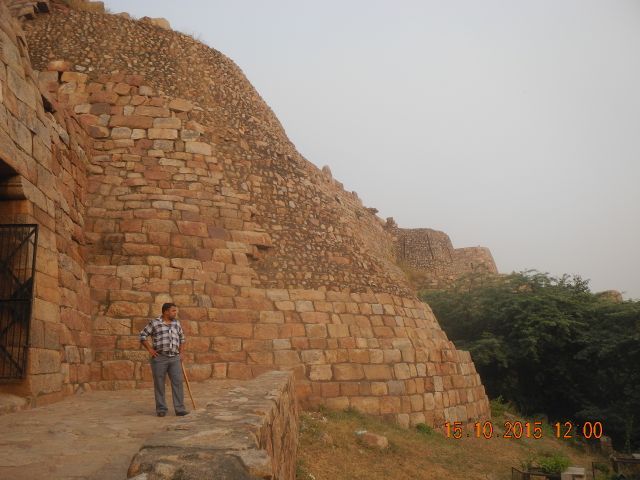
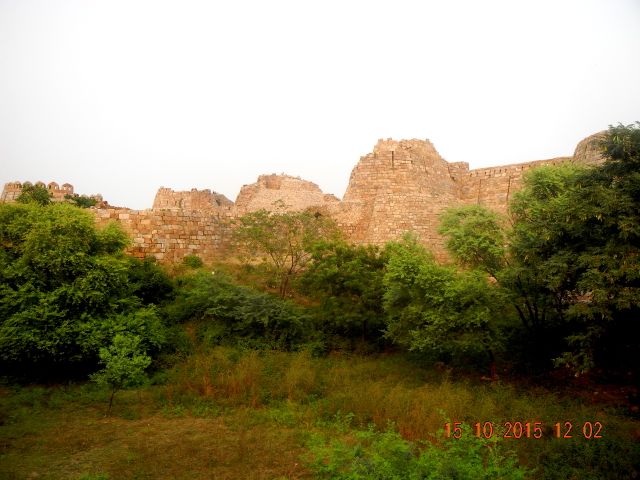
...the man with the big stick to chase them off, here he is outside the south gate, looking east. Inside the gate looking east towards the citadel.
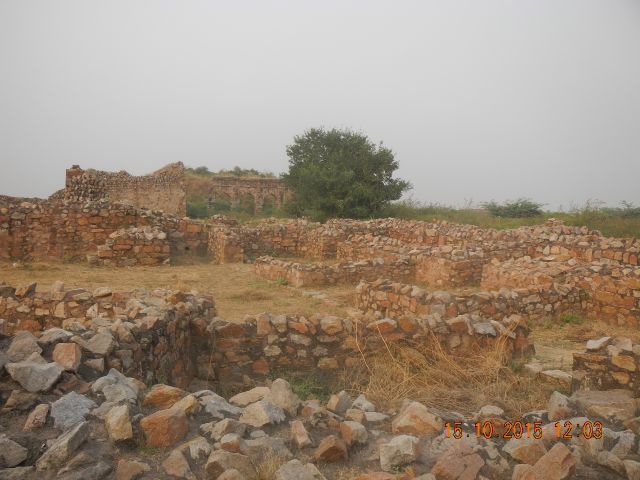

Ruins of the palace complex looking north, it really was this hazy, and the step well looking south.
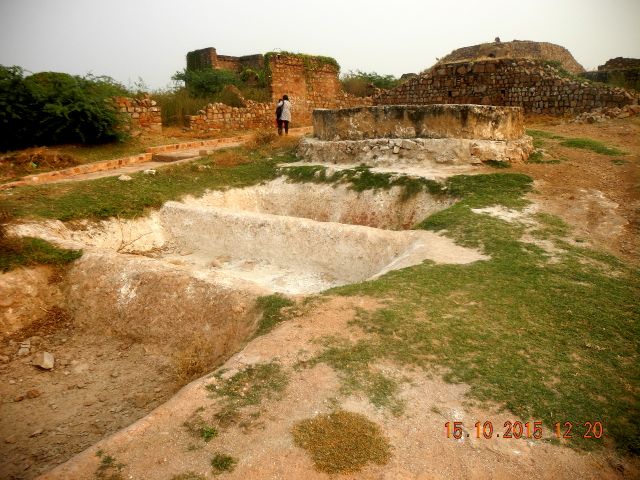
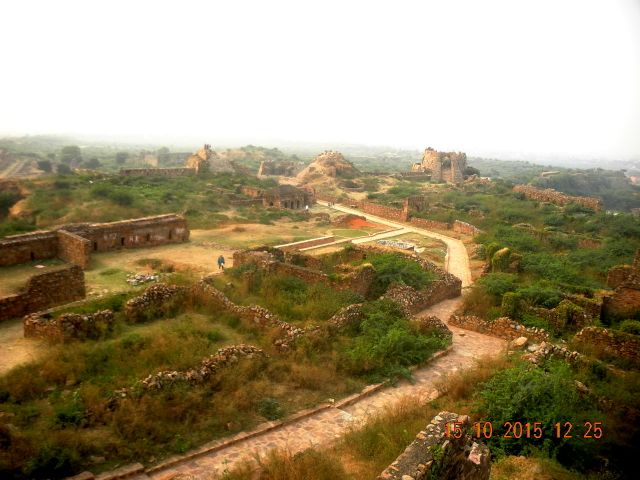
In the citadel looking north east towards the 'keep' across aseries of wash tanks and the view back from the keep across the citadel looking south west.

Tughlakabad Fort

The team admire the publicity outside the theatre.



Scenes at the Anand Restaurant.
THURSDAY OCTOBER 15th.


Views from our room at the Eros: looking east across the metro and down into the gardens. The whole complex was semi-fortified with guards at all the gates to insulate us from the teeming street life and poverty below.
Didn't work though, the fellows went out and found a bar.
The initial plan had been to take the metro in to Old Delhi and the Red Fort but we had been instructed by the ICCR to stand by our bags and await imminent collection which we did in the expectation that some kind of welcome or other event had been laid on which required our attendance. We waited and waited and when eventually we were collected and spirited away to the Eros International Hotel in Nehru Place... nothing. We were checked into this luxurious establishment by smart and attentive staff, found our rooms, had an excellent buffet lunch plus expensive beer but still no contact so we decided to take ourselves off on another visit. In a convoy of three taxis we headed south along the Ma Anandamayee Marg towards Tughlakabad and its famous fortified city remains. The road was a modern highway but was lined with construction debris which never seems get cleared away and Indian men relieving themselves, about one every 250 metres all the way along. Once at the fort our drivers were very attentive and after we purchased our tickets they shepherded us across an impossibly busy road to see first the fortified tomb of the city's founder Ghiyas-ud-Din Tughluq. His city was more or less abandoned immediately after his death in 1324 but the remnants are impressive. The tomb stood on an island in a huge lake which lay south of the town and joined to it by a causeway which one walks along to reach the tomb. The lake is long gone and the causeway breached, of course, by the main road which we had to cross back again.... how about a footbridge chaps? On the other side a custodian preceded us with a big stick to drive off the monkeys as we climbed the ramp up to the south gate. Turning left we walked along past the scattered ruins of the palace quarter to another step well and then retraced our steps and continued the climb up to the adjacent citadel. All hugely atmospheric as the sun started to set and cast a red glow over everything through the haze of pollution. We were accompanied by a very determined old man who tried to offer us a guided tour but as we seemed to know more than he did it was rather pointless. He seemed rather offended when at the end I offered him my notes, perhaps he thought I was selling them. On the way back, as is traditional our drivers offered us the opportunity to go shopping but we declined.

The on-site sit plan, unfortunately there is no scale, the whole complex is around 2.5 kilometres east to west


View of the city wall looking north, we are still a couple of kilometres from the ticket office, the site is huge. Ticket office and portion of causeway looking north east plus litter.


The fortified enclosure looking south and the tomb looking north.


Inside the east bastion the prime minister Jafar Khan's tomb. Back on the causeway to the fort, monkeys wait for...


...the man with the big stick to chase them off, here he is outside the south gate, looking east. Inside the gate looking east towards the citadel.


Ruins of the palace complex looking north, it really was this hazy, and the step well looking south.


In the citadel looking north east towards the 'keep' across aseries of wash tanks and the view back from the keep across the citadel looking south west.

Tughlakabad Fort
FRIDAY OCTOBER 16th.
A certain amount of hanging about then a call, 'bus arriving at 10.30' to take us to the Kamani auditorium for a sound check and rehearsal. Neither were really necessary but we went anyway then back to the Eros for a slap up meal in the posh restaurant then back to the theatre for more sitting around before our 35 minutes spot between two dour Spanish musicians and a lively group of young dancers from Kyrgyzstan. We developed a fiction with the audience that they were witnessing us doing our thing outside in a typical English pub car park. It all seemed to go well
A certain amount of hanging about then a call, 'bus arriving at 10.30' to take us to the Kamani auditorium for a sound check and rehearsal. Neither were really necessary but we went anyway then back to the Eros for a slap up meal in the posh restaurant then back to the theatre for more sitting around before our 35 minutes spot between two dour Spanish musicians and a lively group of young dancers from Kyrgyzstan. We developed a fiction with the audience that they were witnessing us doing our thing outside in a typical English pub car park. It all seemed to go well

The team admire the publicity outside the theatre.
SATURDAY OCTOBER 17th.
After some phoning around we finally got through to someone who was both well organised and spoke sense. We discovered that our venue for the evening's performance was the Baha'i auditorium attached to the famous Baha'i Lotus Temple which was just round the corner. With this in mind we all set out to visit Old Delhi and the Red Fort or Lal Qila via the Delhi Metro. The system is fairly new and worked well from a technical point of view, the only drawbacks from my point of view is that it is hideously crowded and runs some distance underground, now I'm not too good underground or in confined spaces (people have pointed out in the past that this is a bit of a handicap for an archaeologist) so the whole thing was quite challenging. We traveled from Nehru Place to the Central Secretariat then changed lines to head on to Chandni Chowk, the station for the main shopping drag through the old town to the Red Fort. Once out of the station it took us some time to orientate ourselves and there was a certain amount of harassment from local 'guides' who had to be sent packing. Eventually with the help of map on phone and GPS we emerged onto the thronged thoroughfare for the kilometre of so walk to the fort. Once again large numbers of touts but we pressed on, obtained tickets and ended up passing through the Lahore Gate and into the fort... which was terribly disappointing: shabby, litter strewn, badly maintained, poor access and all the fountains, pools and water channels dry and dusty. The fort was built between 1639 and 1648 at the behest of the emperor Shah Jahan but was sacked by the Persians in 1739 and the British in 1857. We had a good look round and Verna had to tell them to clean up the toilets and then it was time to go. I hadn't mentioned that this was a festival weekend so the streets by now were completely solid with the press of humanity and assorted vehicles. Nevertheless we decided to take a load of cycle rickshaws back to the metro, no we didn't want them to take us round the bazaar or back to our hotel, just the metro please and once they got the message they were very good at keeping us together as they threaded their way through the all but grid locked traffic.
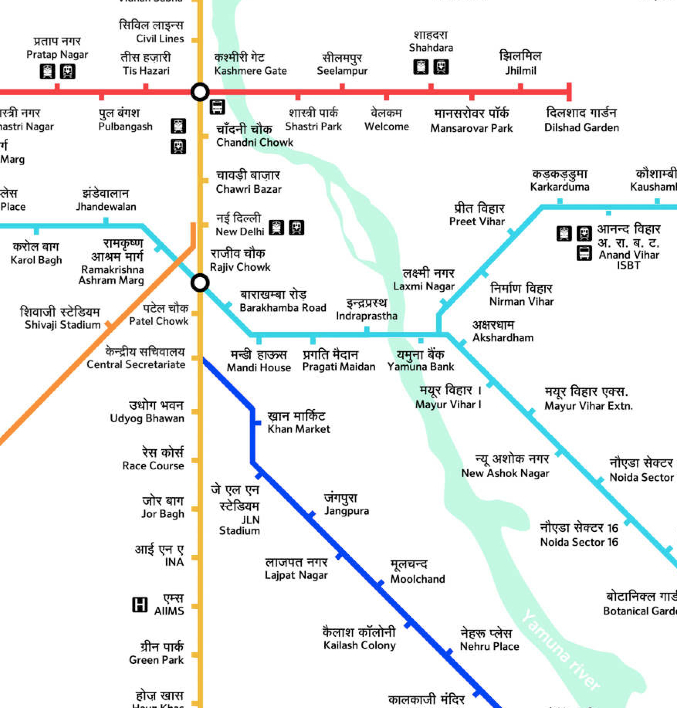
You can trace our route from Nehru Place to Chandni Chowk
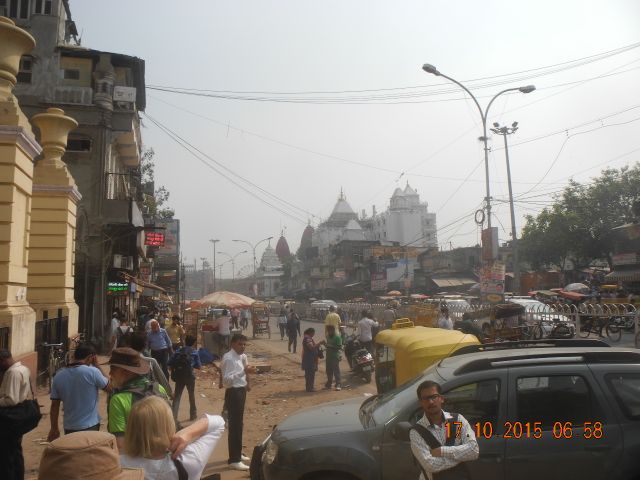
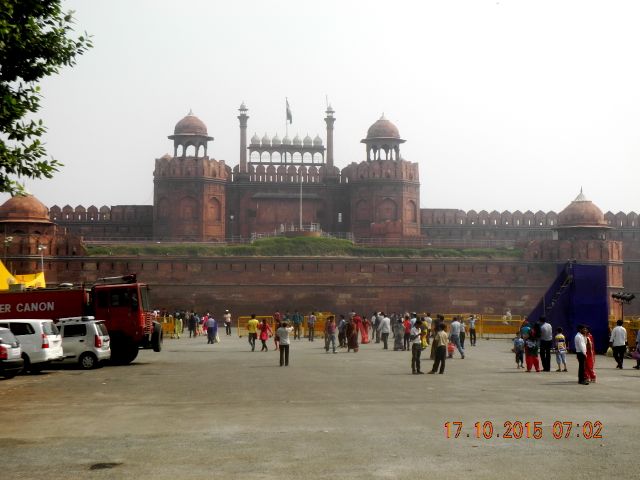
Looking east along Chandni Chowk towards the Jain Temple and bird hospital. The open space in front of the Lahore Gate looking east.
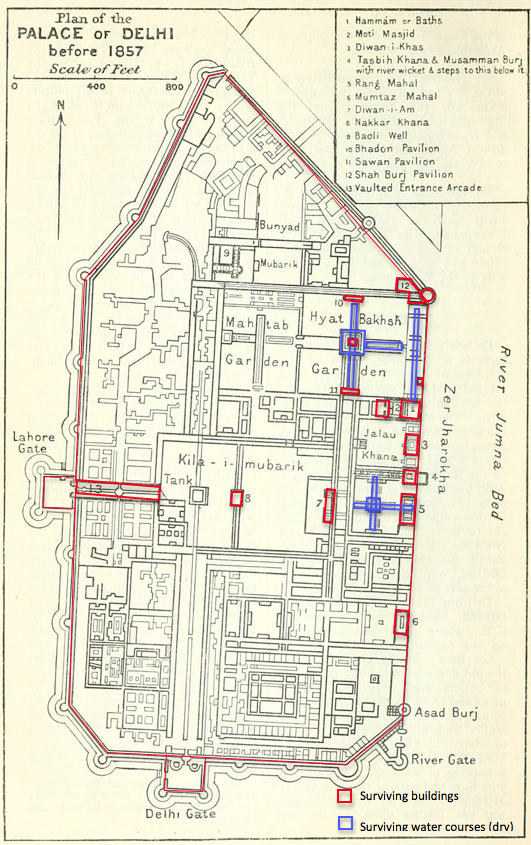
Another unattributed plan I'm afraid but annotated by me to show what's left after the attack and destruction by the British in 1857

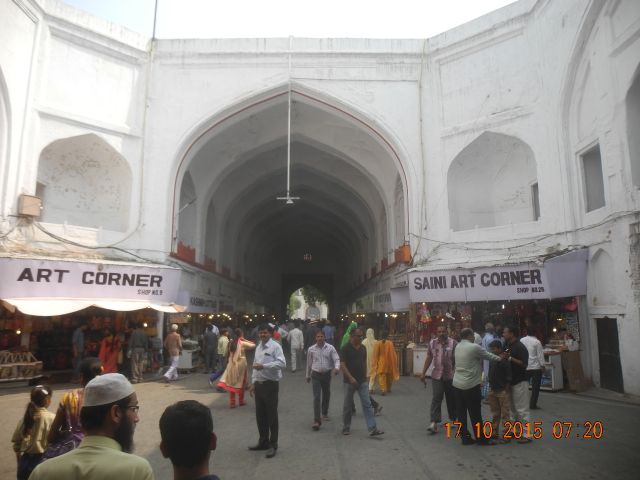
The barbican in front of the Lahore Gate looking south east. Chatta Chowk, constructed as a bazaar to give accommodation to the city's finest craft workers, now sells souvenirs, looking east.
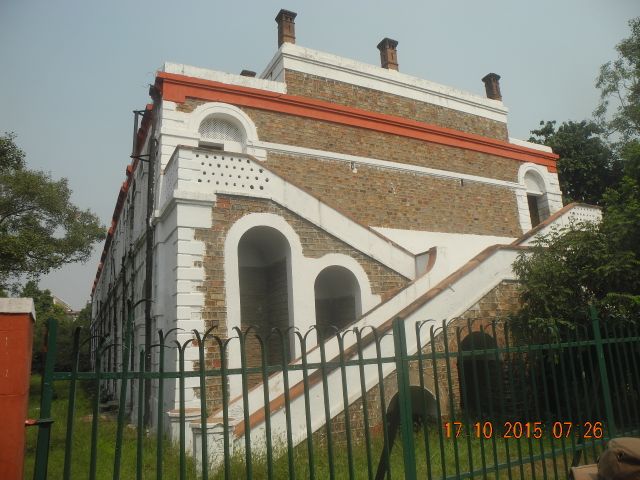
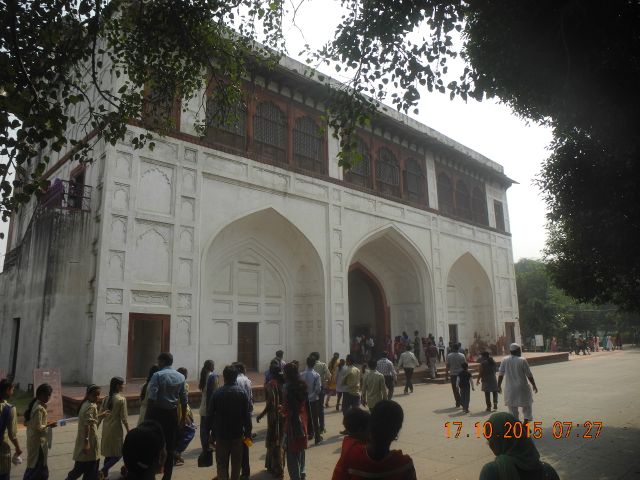
One end of the series of barrack blocks built post 1857 by the British, looking north. The Naubhat Khana or Drum House looking south east.
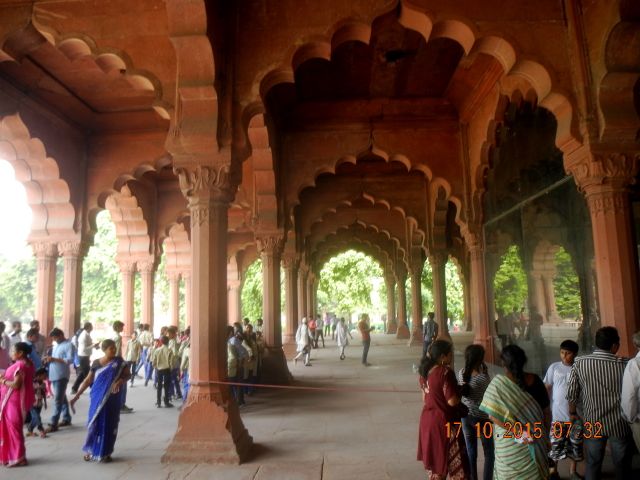
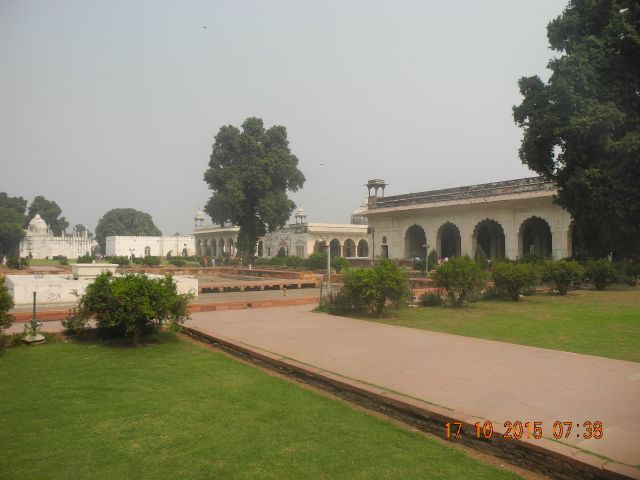
The interior of the Diwan-i-Am or Hall of Public Audience looking north. Gardens and fountain in front of the emperor's private quarters, the Khas Mahal looking north east.

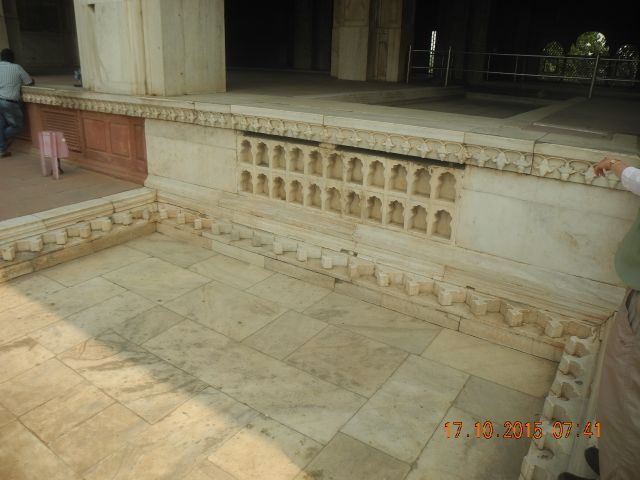
The Khas Mahal internal pool, niches and external pool views looking north east. Golden flowers or lit candles were placed in the niches which then shimmered behind a curtain of falling water, not any more.
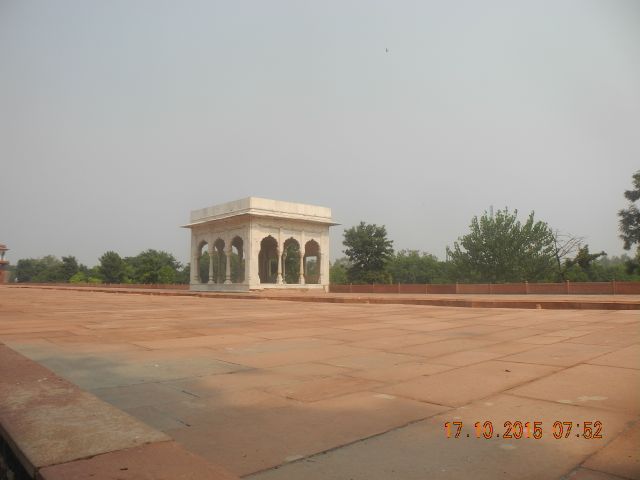
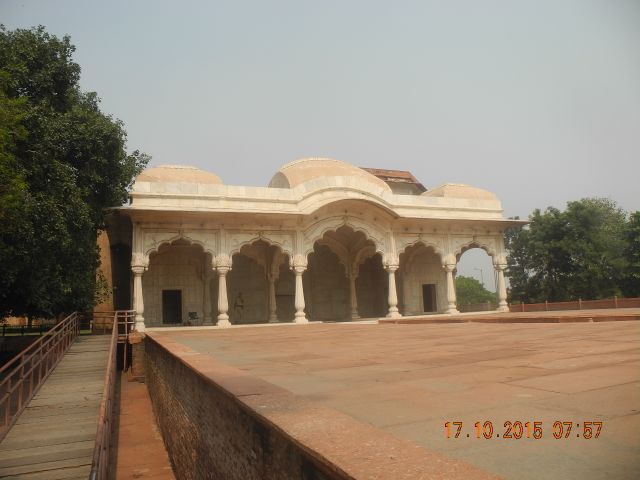
Pavilion above the 'Stream of Paradise' the name given to the channeled water which ran through the palace, looking north east
and the Shah Burj another pavilion masking the water tower behind into which water was pumped from the Yamuna River to the east.

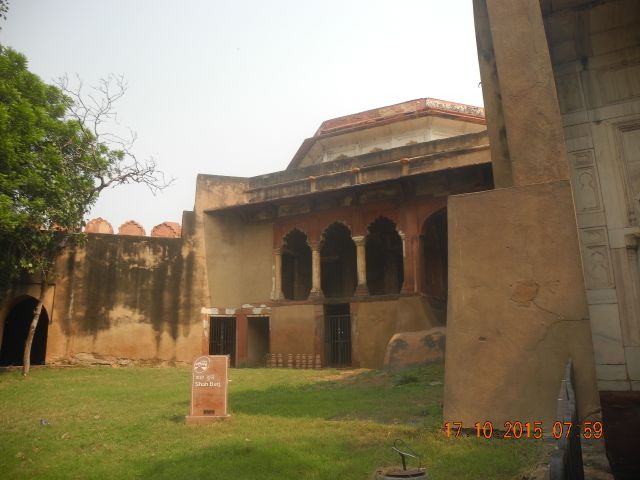
Interior of the Shah Burj showing armed guard and the textured ramp down which the incoming water flowed plus a view to the rear showing the top of the octagonal water tower, both looking north east.
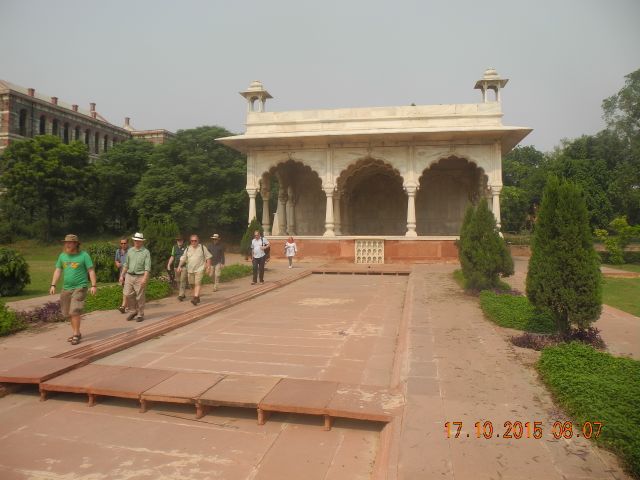

The Hayat Bakhsh Bagh, the only surviving formal garden: The Bhadon Pavilion looking north and the Zafar Mahal of 1842 which once stood at the centre of a square pool looking north east.
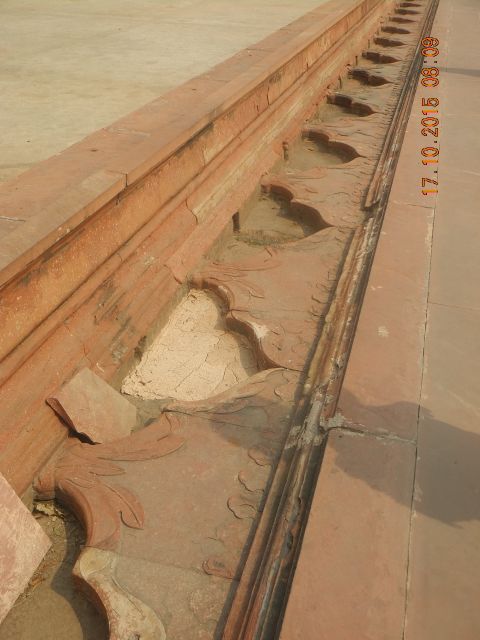
Detail of the channels and small ornamental basins surrounding the central pool, looking north east.

The Red Fort
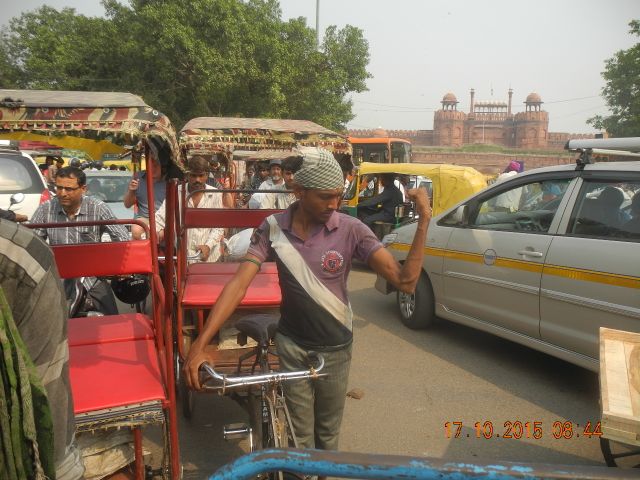
Cycle rickshaw rider on the Chandni Chowk demonstrates his strength...
* Thanks to Rajnish Prasad for the following photographs

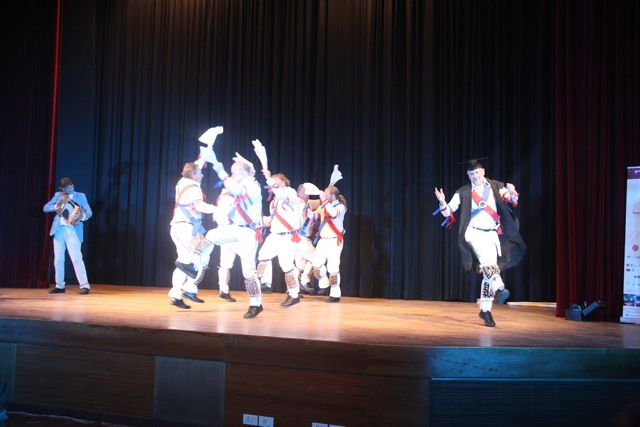
Performing at the Baha'i Auditorium*
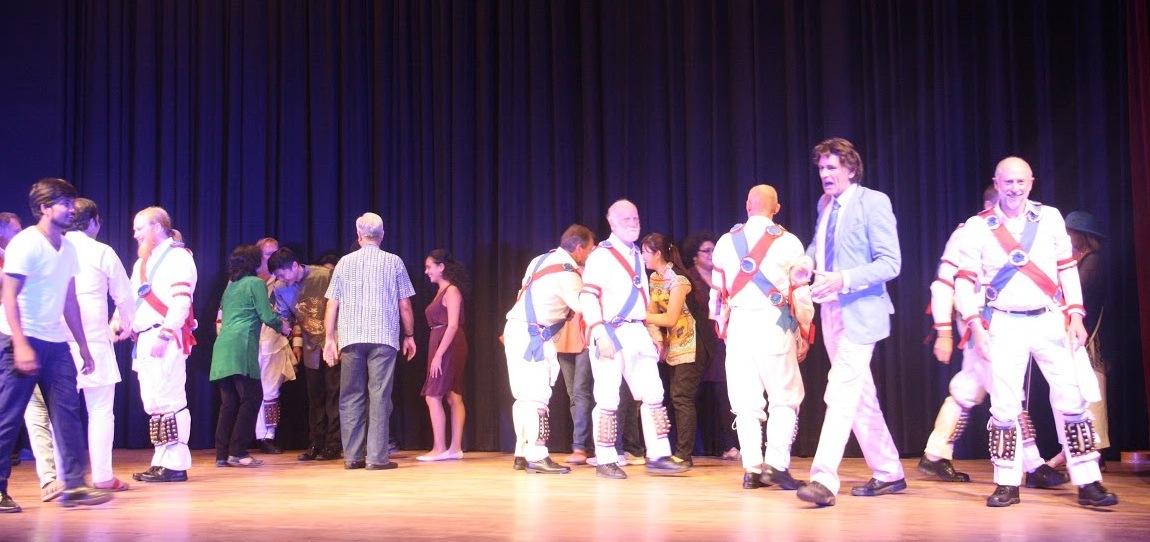
Preparing for our farewell dance*.
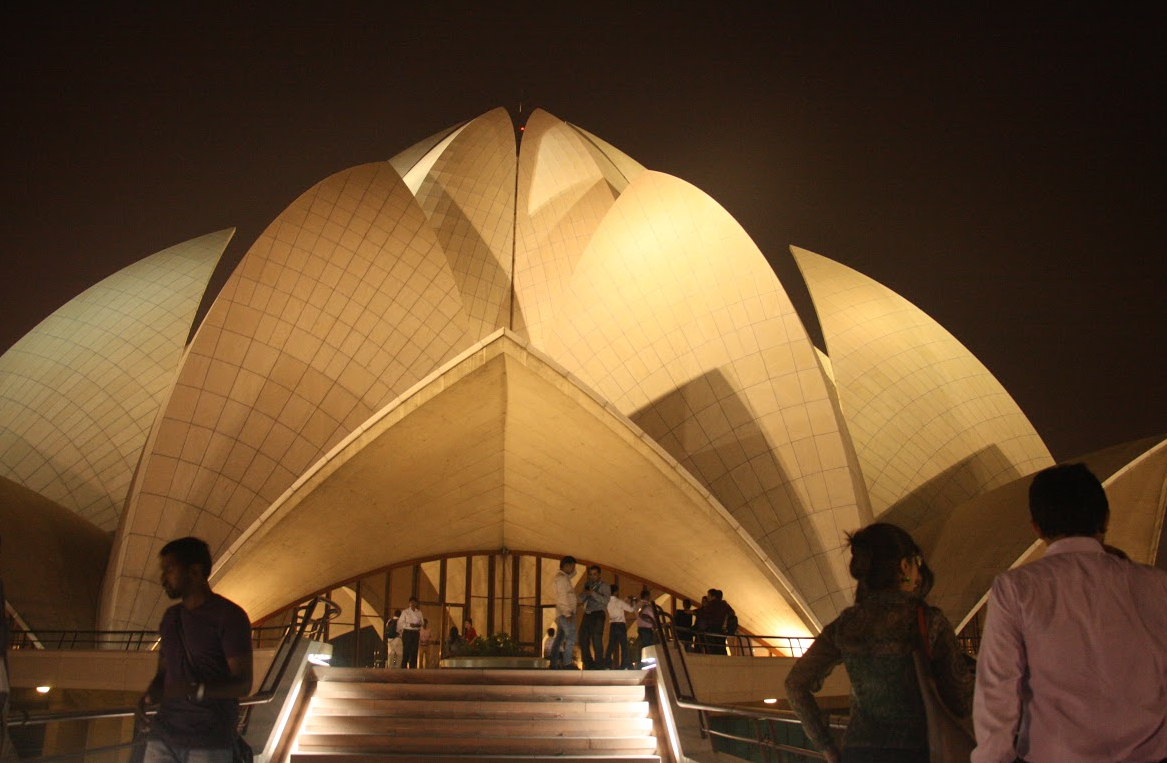
The Lotus Temple*
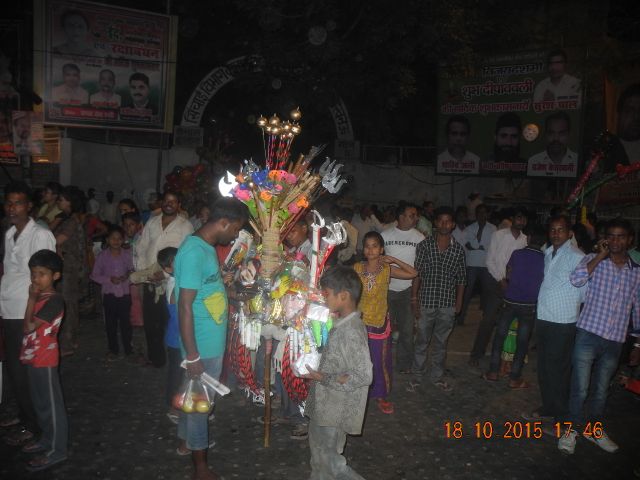
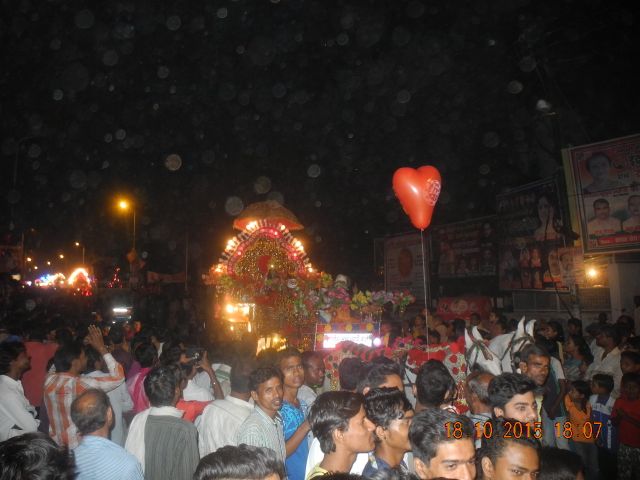
The festival of Dusshera, not sure what's being sold but here comes the procession...
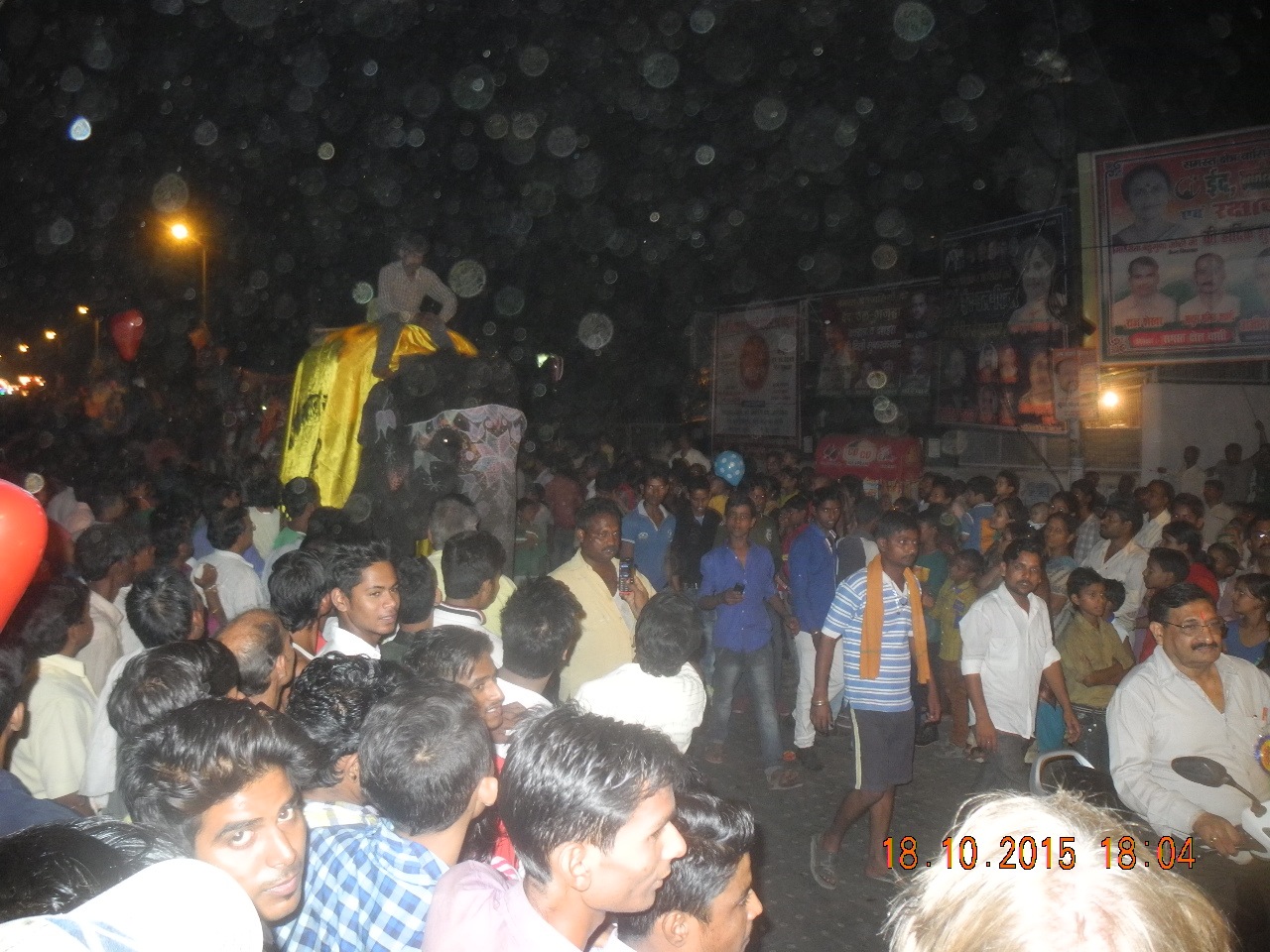
.... plus elephant! (The shiny circles are the flash reflected off the dust in the air!)
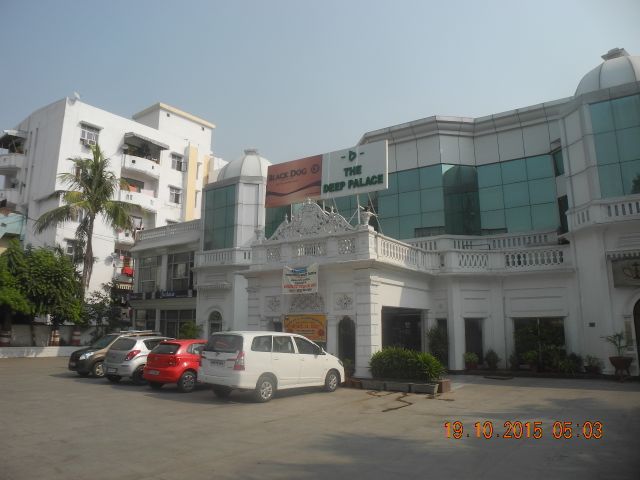
The Deep Palace Hotel.
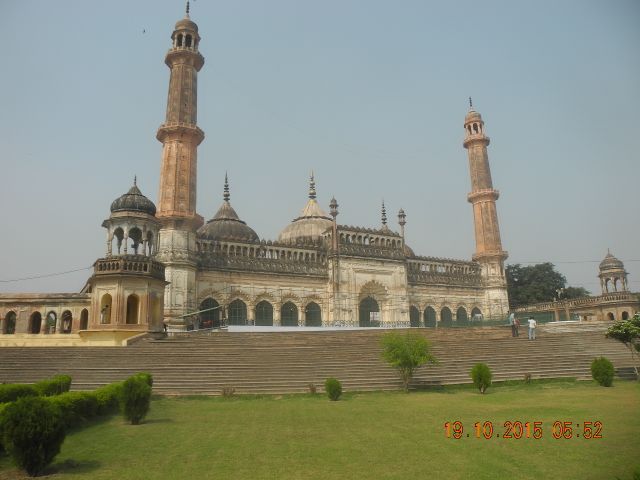
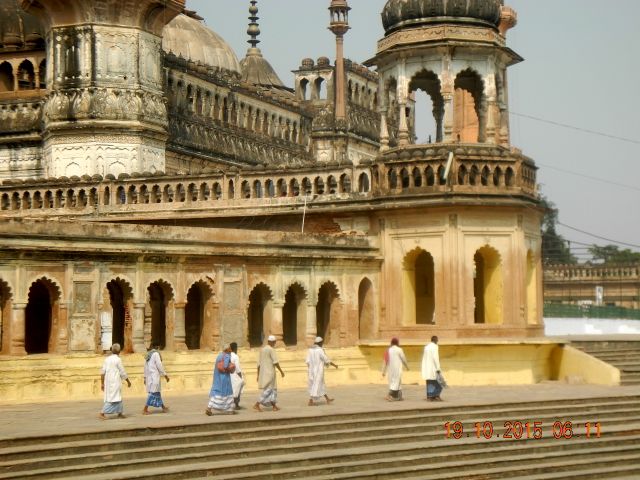
The mosque at Bara Imanbara looking north west with view of approaching pilgrims.
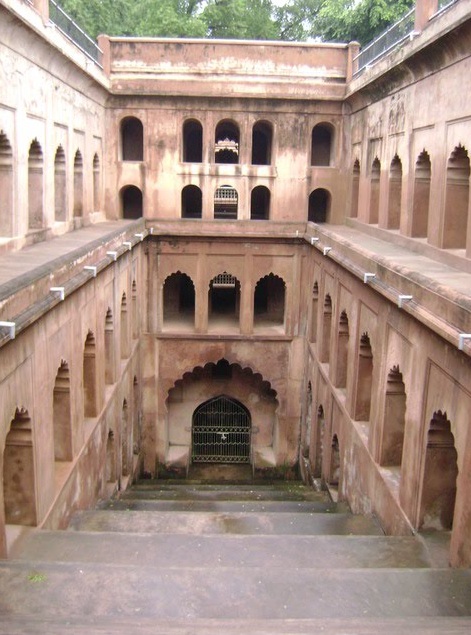
The step well, not my photo unfortunately.
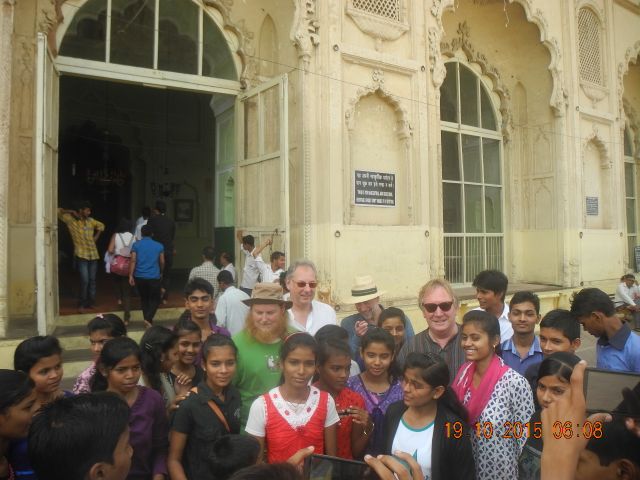
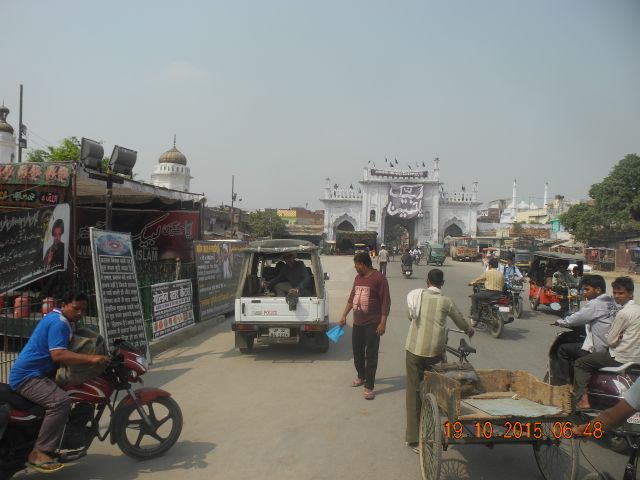
Outside the Bara Imanbara we were asked to line up and have our photos taken, always keen to oblige, and here is Pete hitching a ride with our police escort, brave man.
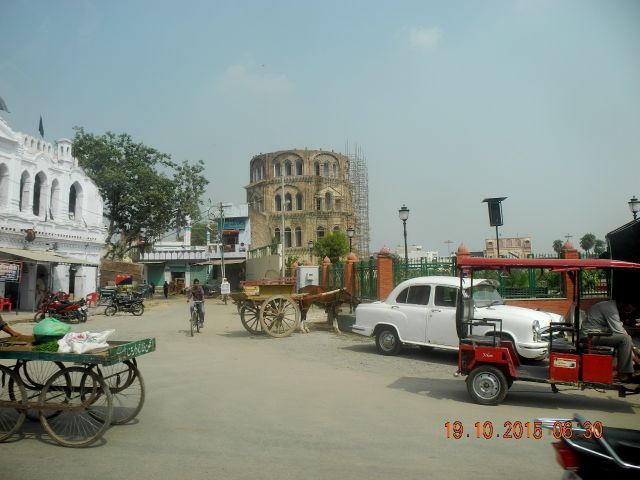
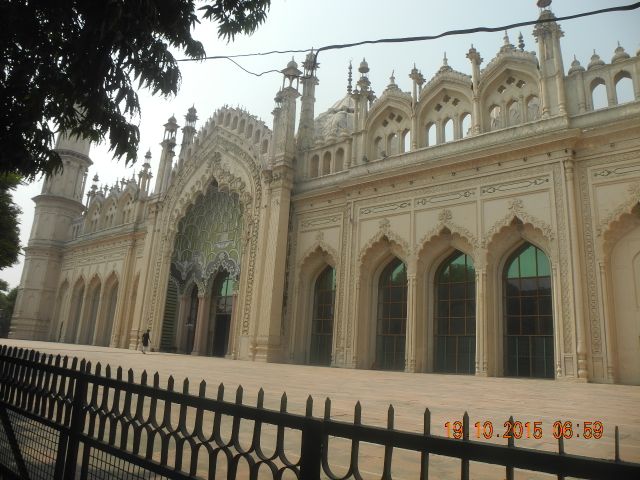
The Satkhanda a watch tower cum observatory from the late 1830s looking north and the entry front of the Jama Masjid looking south east.
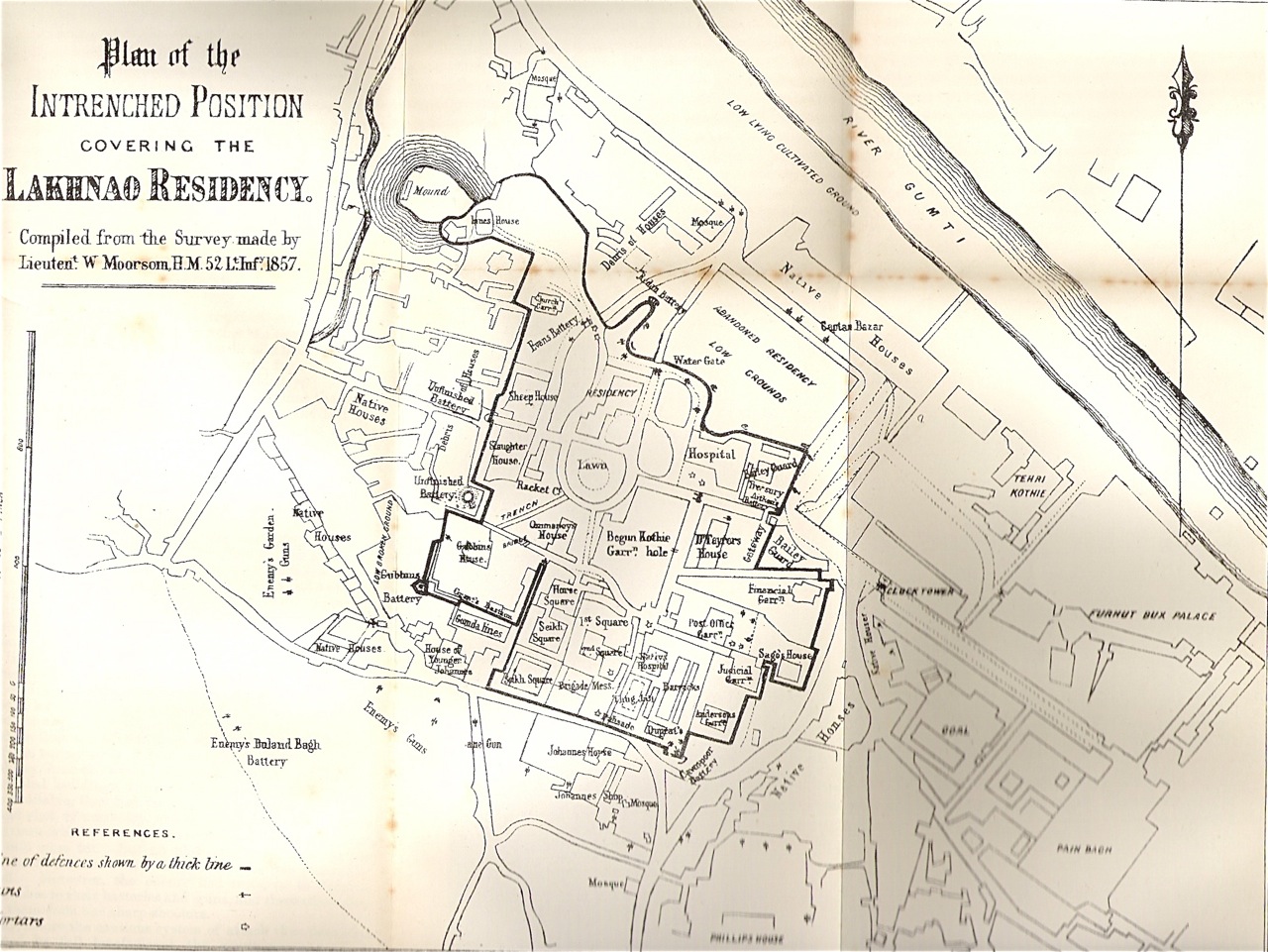
The Lucknow Residency complex at the time of the siege in 1857.
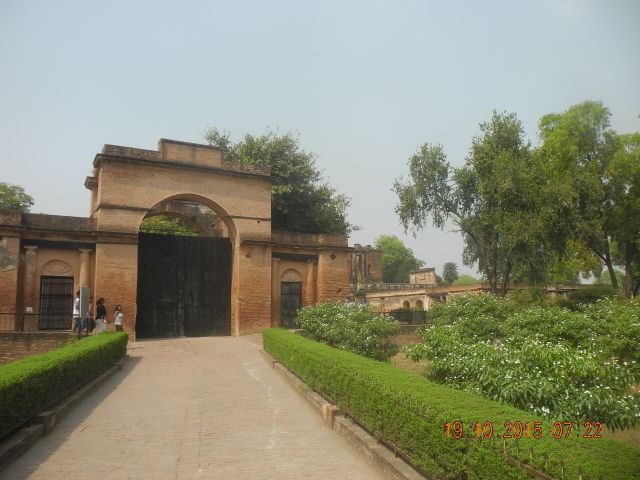
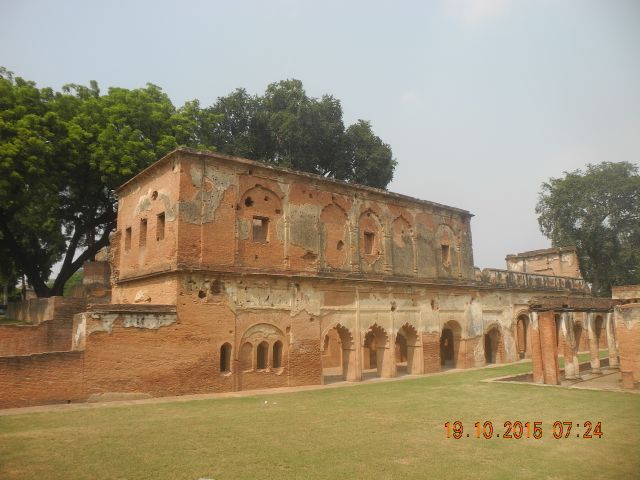
The Bailey Guard Gate from the east. The treasury from the south, note damage from cannon balls.
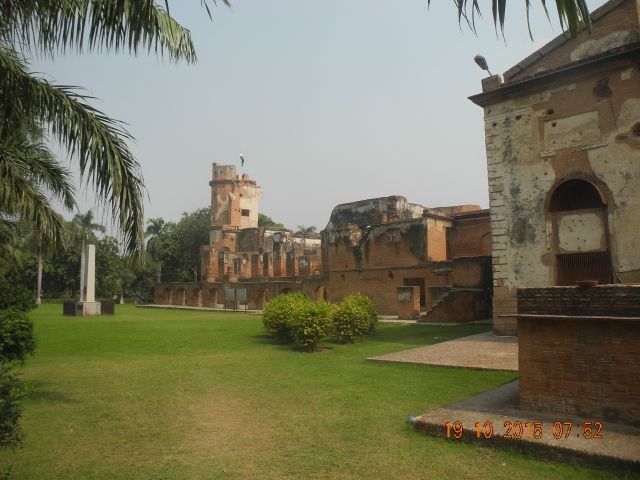
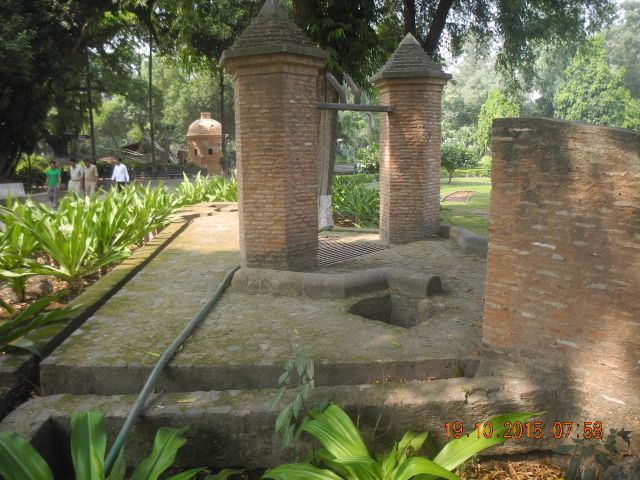
The Residency from the south west. Well and water channels from east on edge of the lawn south of museum
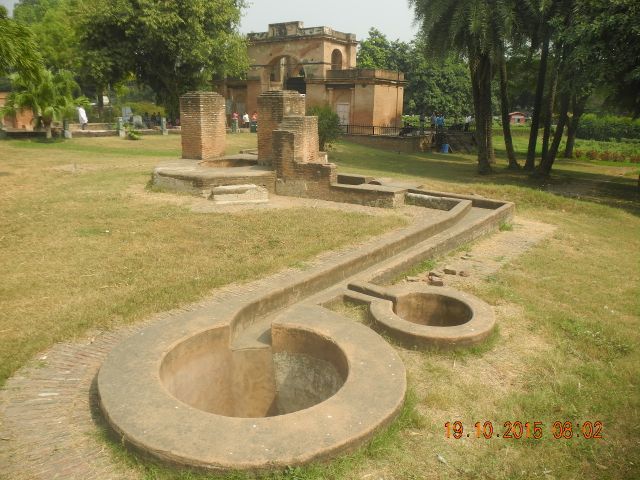
Another well plus channels and circular tanks east of Dr. Taylor's House
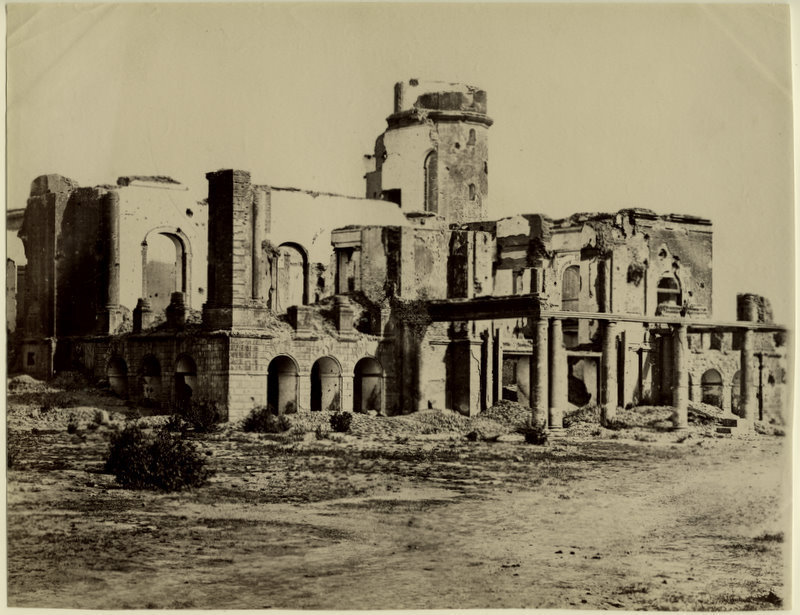
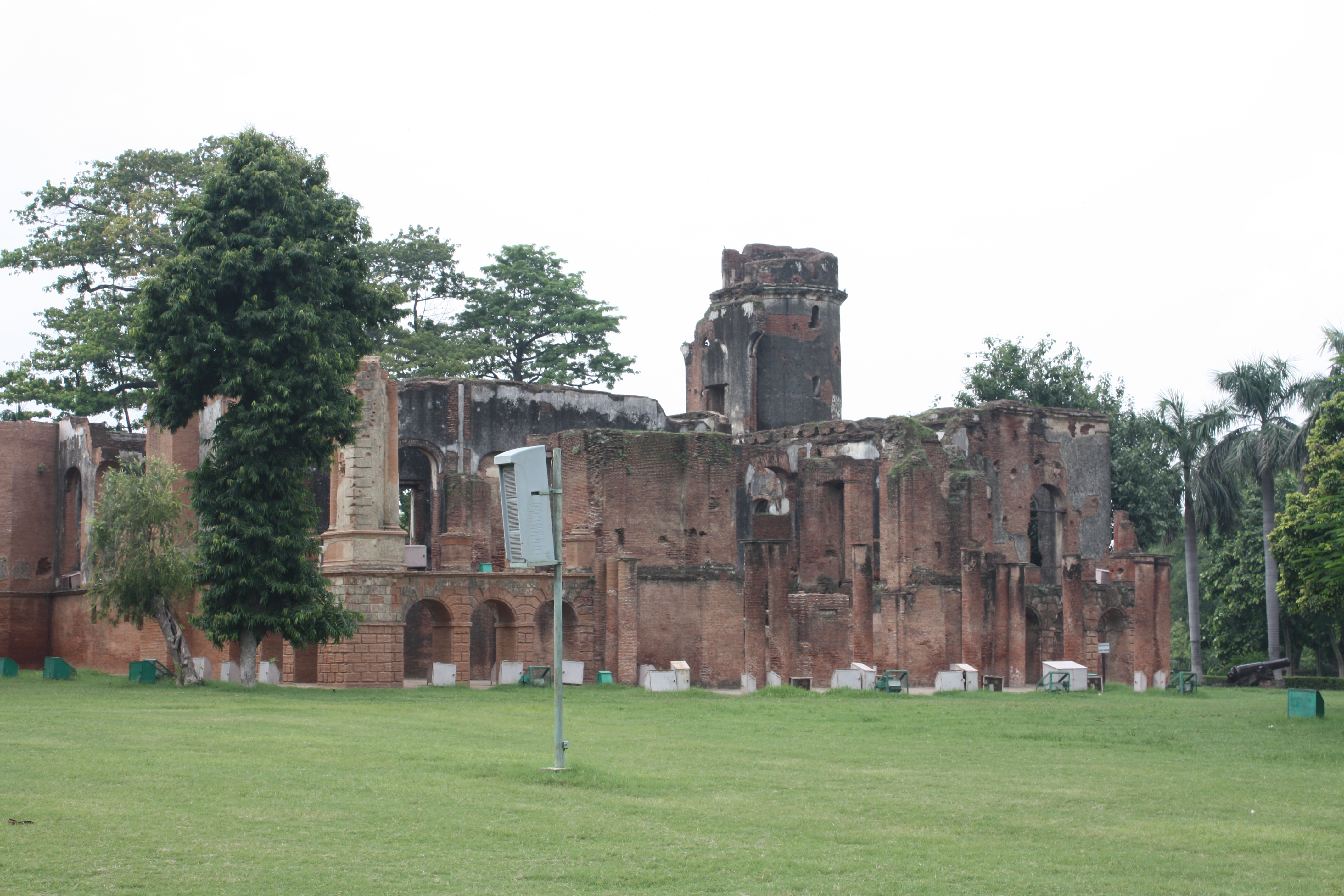
Photo of the Residency immediately after the siege plus same view looking north west in 2015.
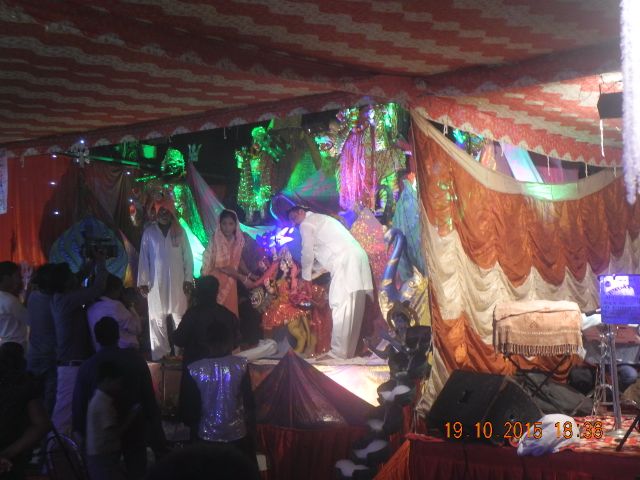
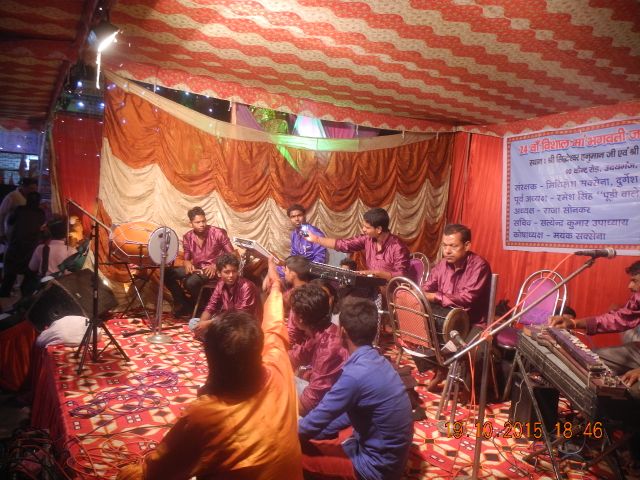
Back on the street that evening, Dusshera rituals underway and the boy band in waiting.
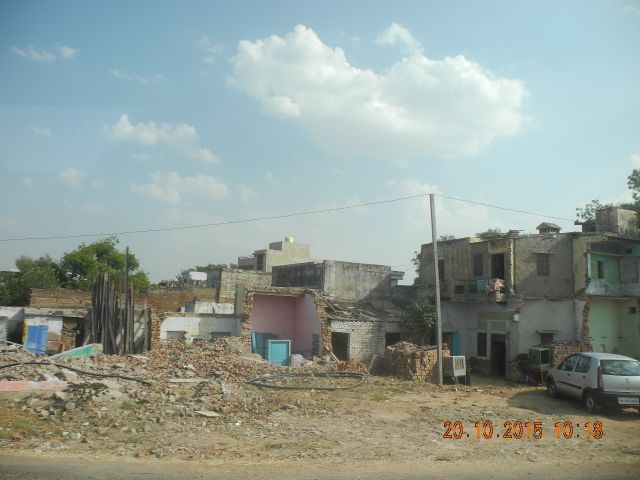
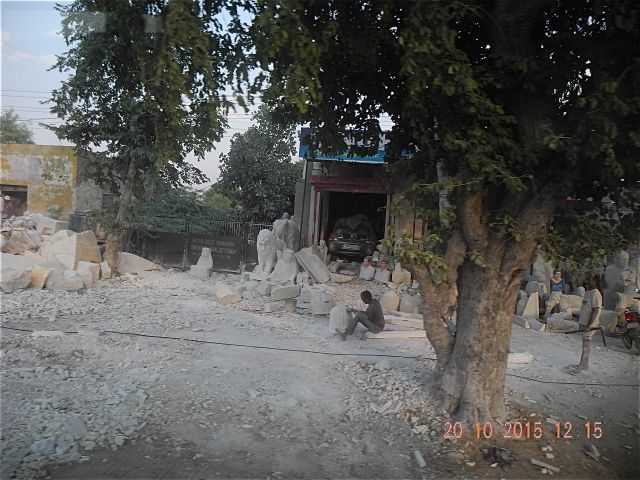
Truncated accommodation en route to Jaipur. A stone cutters workshop with mounds of stone chippings.
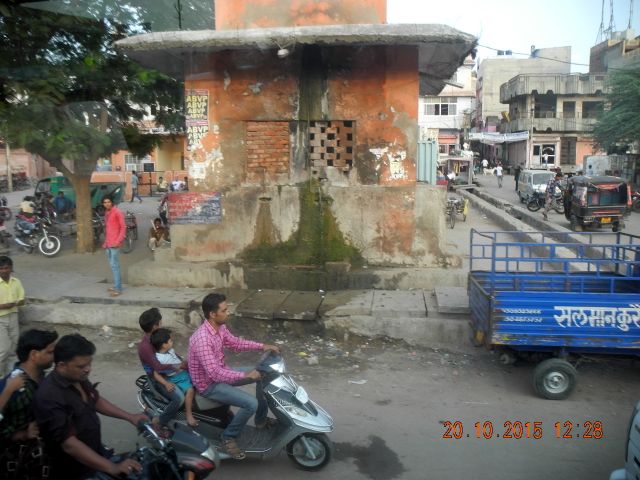
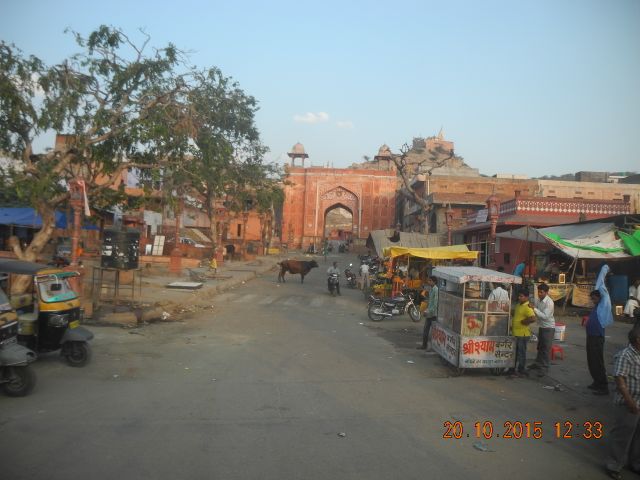
Water point on the outskirts of Jaipur and the first of the many gates we saw to the planned city.
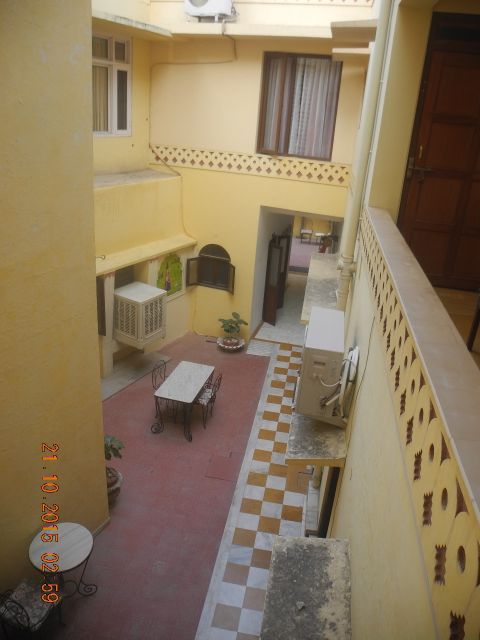
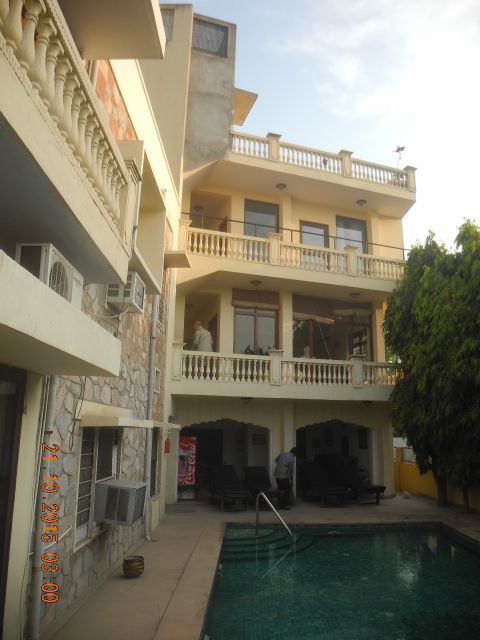
Two views of the Dera Rawatsar: the internal courtyard and pool.

It had to be done, the inevitable photo of the hugely impressive Hawa Mahal or Palace of the Winds, view looking south west.
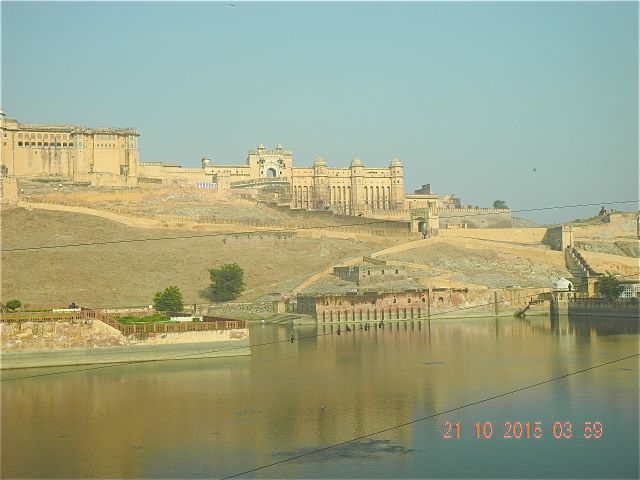
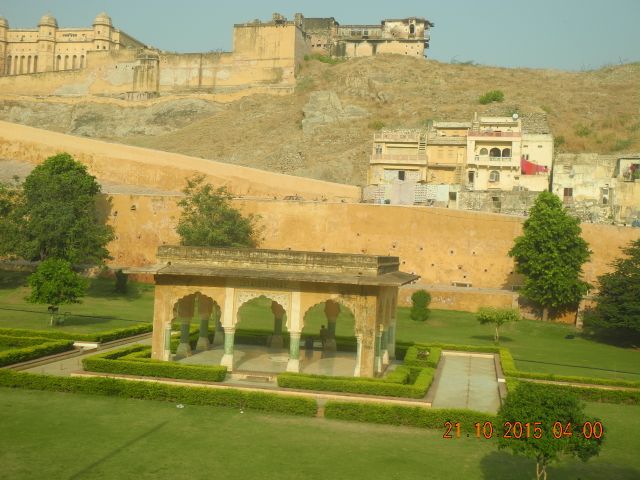
Approaching Amber: looking north towards the palace across the lake and associated formal gardens below the palace.
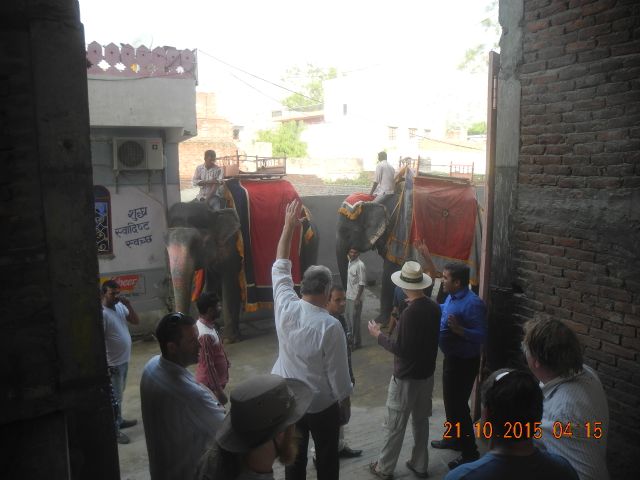
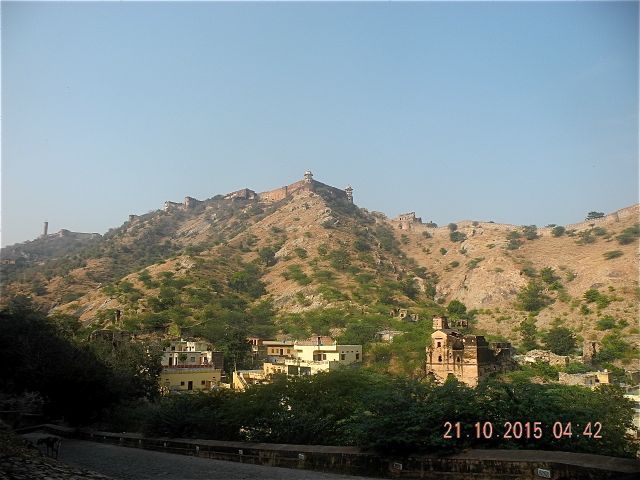
Hands up for an elephant ride. View of the Jaigarh Fort above the palace looking north.
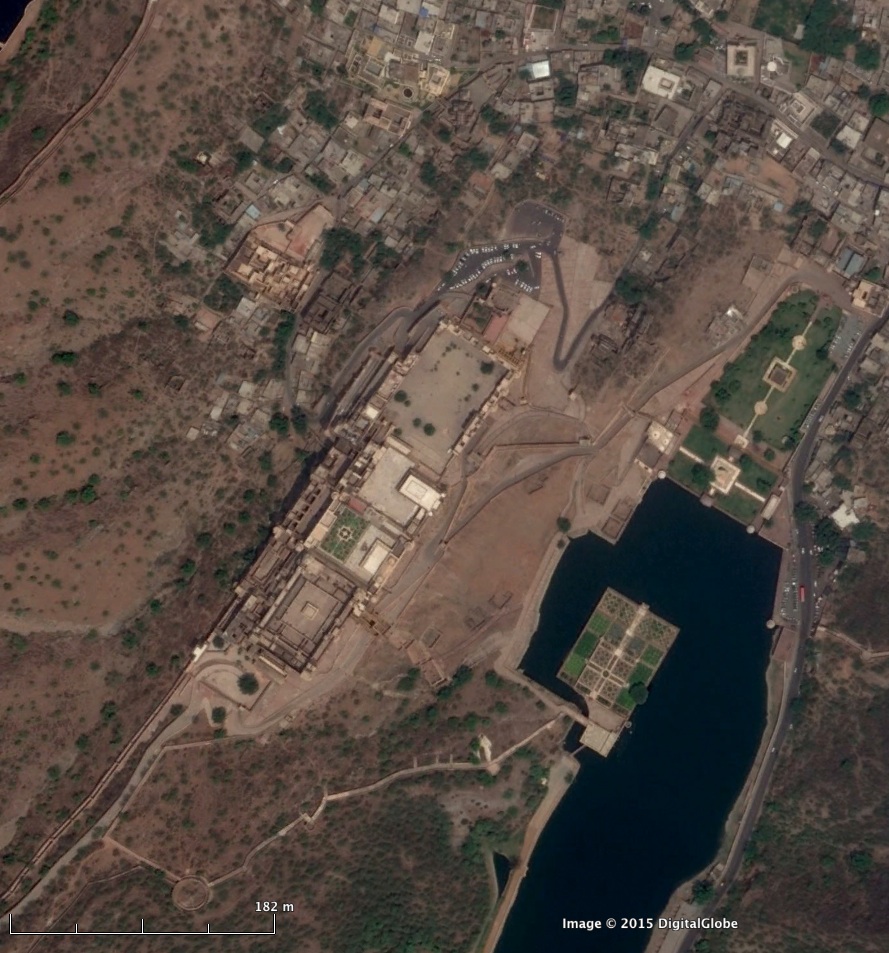
The area of the Amber Fort.
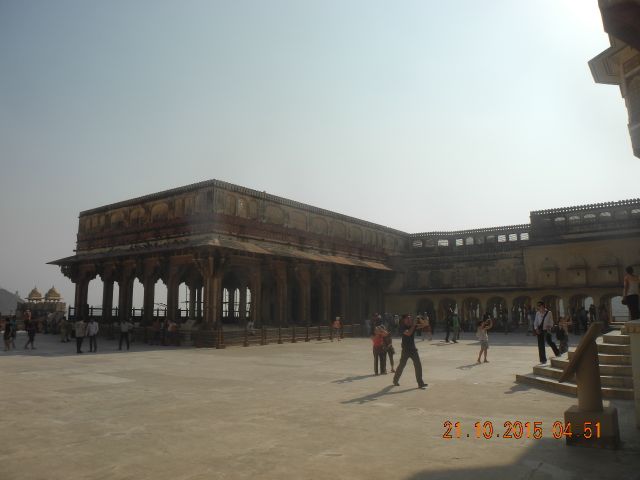
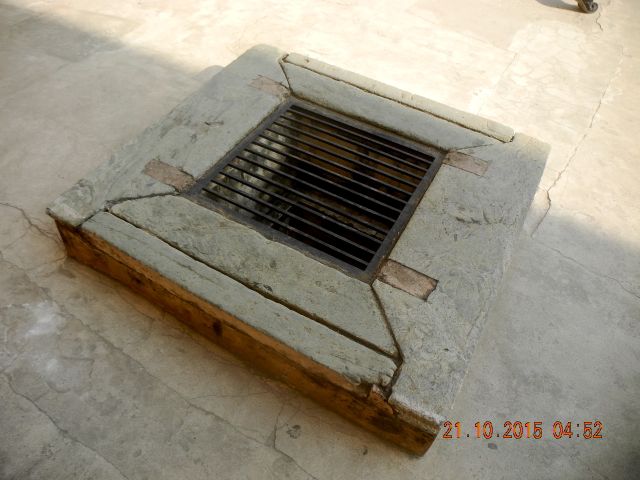
Amber Fort: courtyard with the Diwan-i-Am or Hall of Public Audience of 1639 looking east. Below the courtyard is a large cistern, this is one of the hatches that gives access to it.
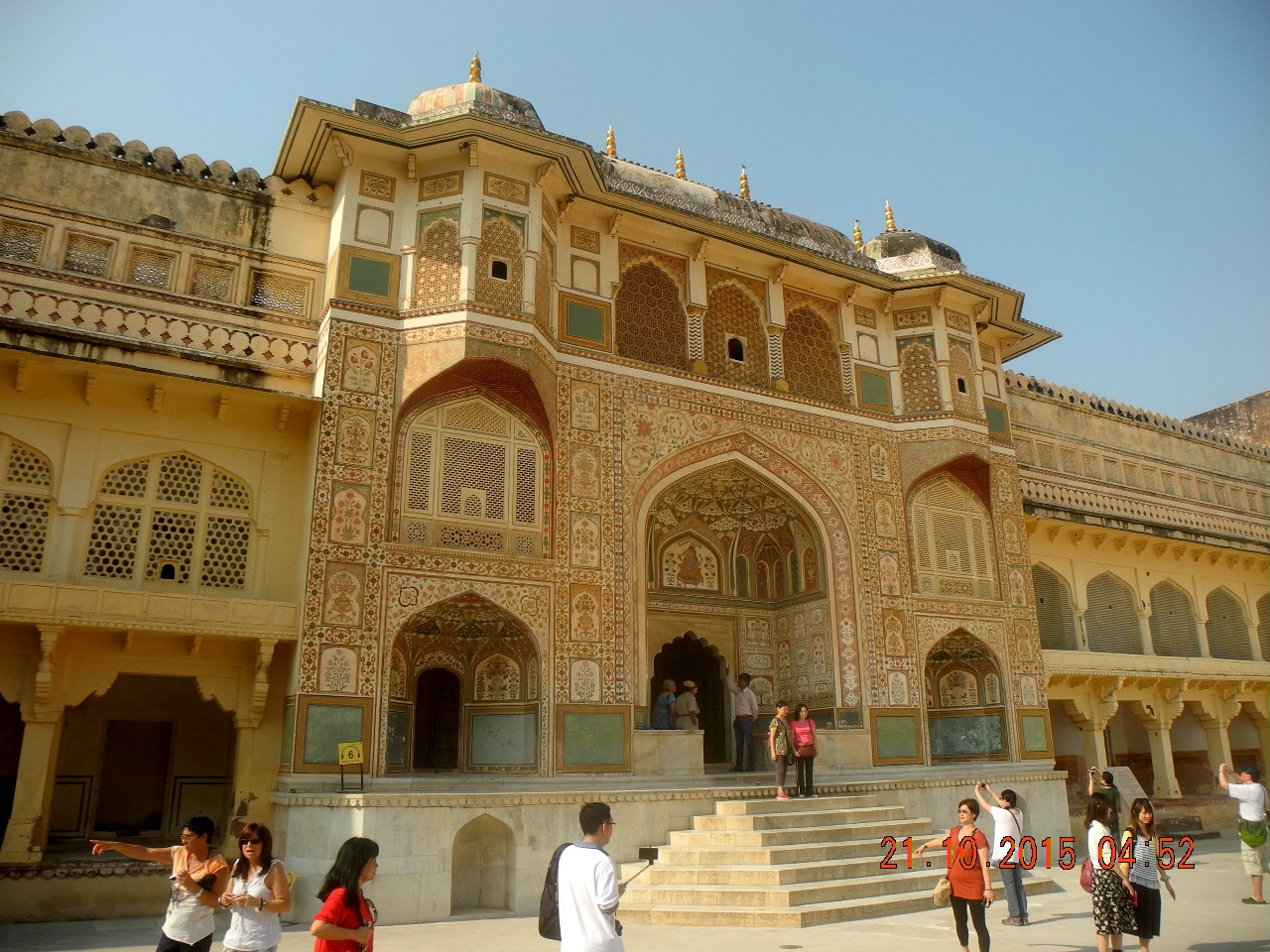
The magnificent painted gateway known at the Ganesh Pole view looking west.
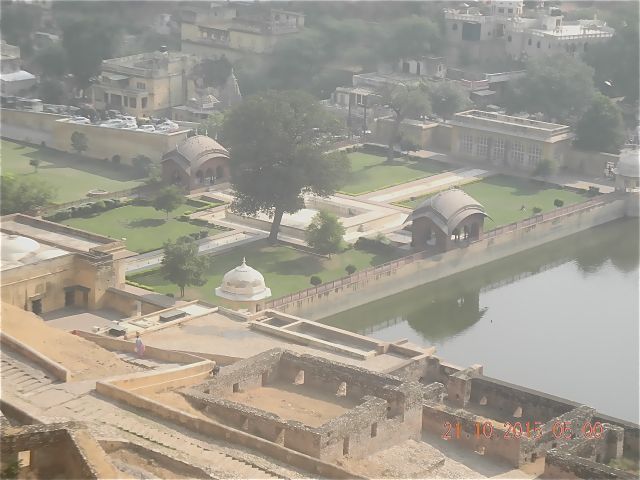
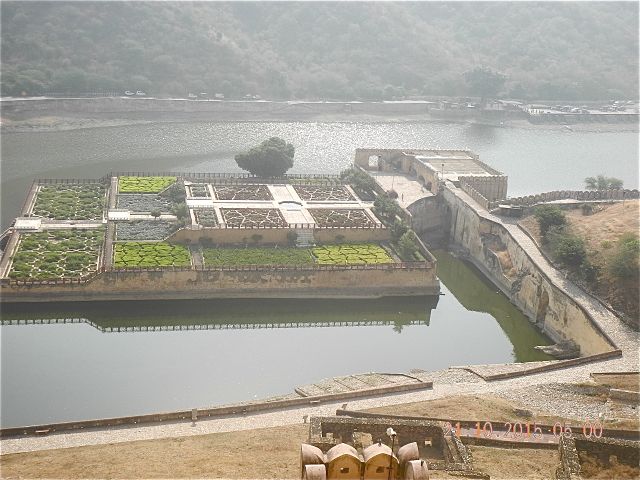
Rather washed out views of the Amber Fort Gardens and dam and the famous Kesar Kyari Bagh or Saffron Garden sitting in the Maotha Lake, both views looking more or less south and so into the sun.
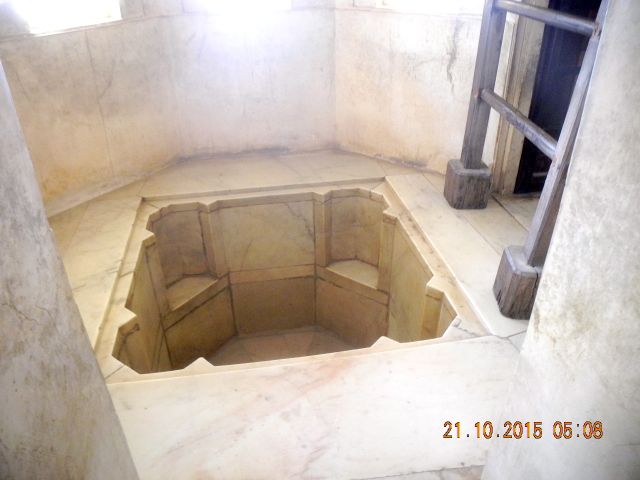
Sunken bath within the hammam with seating for four.

Up to the next level, the gardens sandwiched between the Sukh Mahal and the Sheesh Mahal. view looking west.
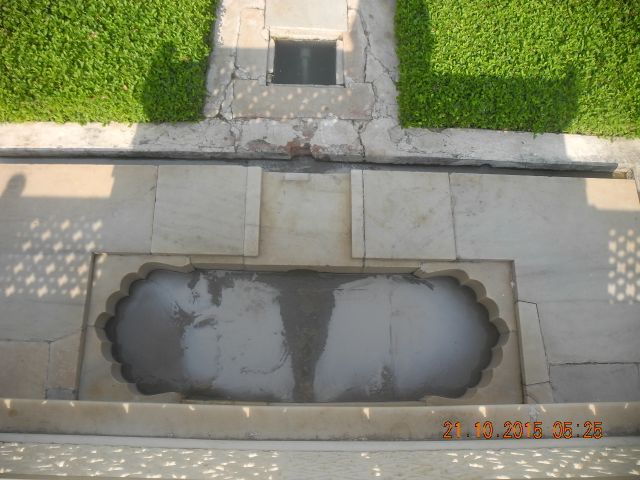
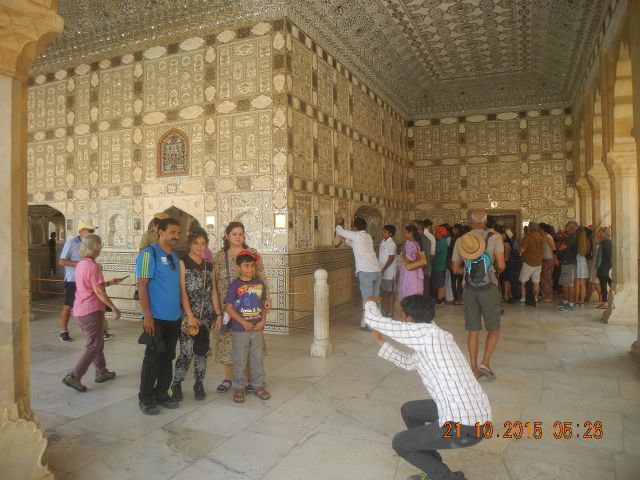
Basin and channel leading into the garden from the Sheesh Mahal, view looking north west plus tourists enjoying the Sheesh Mahal.
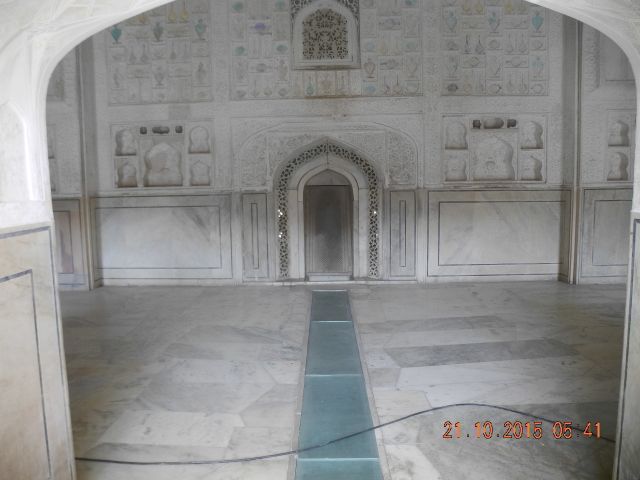

Waterworks designed to cool within the Sukh Mahal: textured ramp and channel looking north west and further ramp and steps down to the garden looking south east.
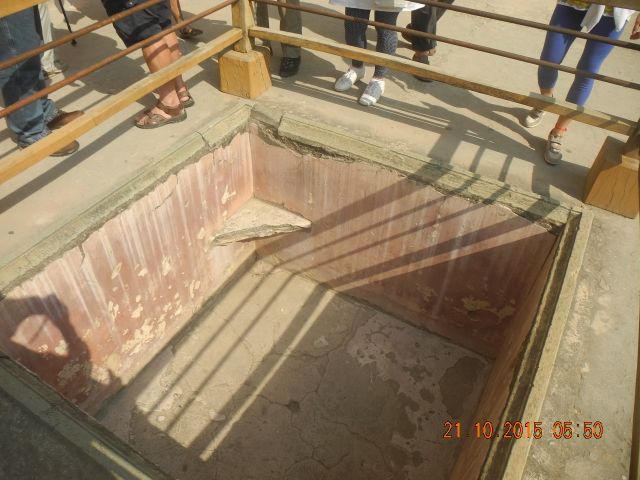
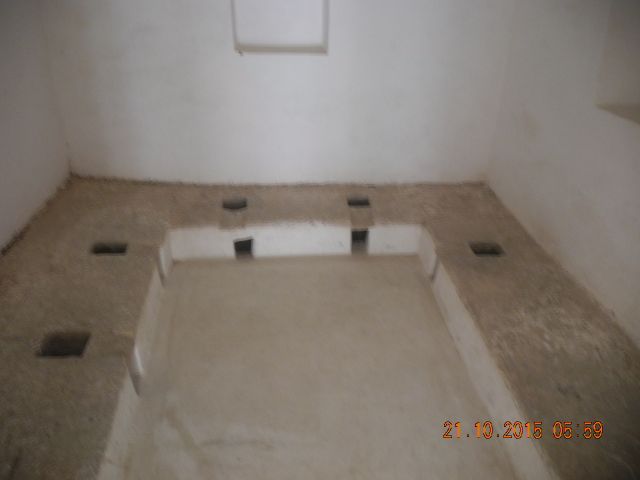
More details of facilities: the small bathing pool within the women's quarters and the toilets looking remarkably Roman, form follows function I guess.
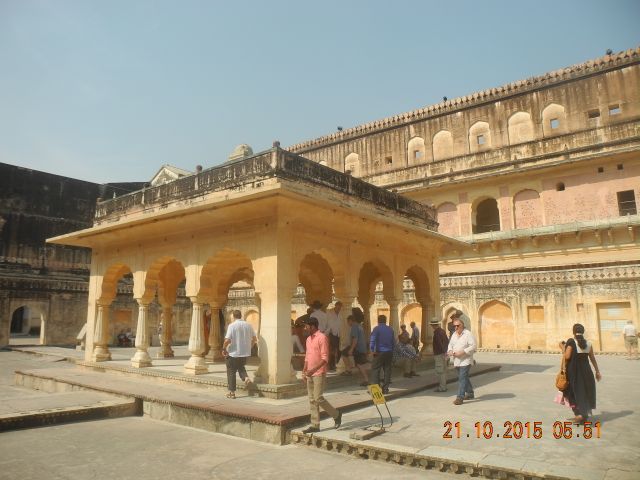
The pillared baradari within the courtyard of the earlier Palace of Man Singh I adapted as the women's quarters, view looking west.
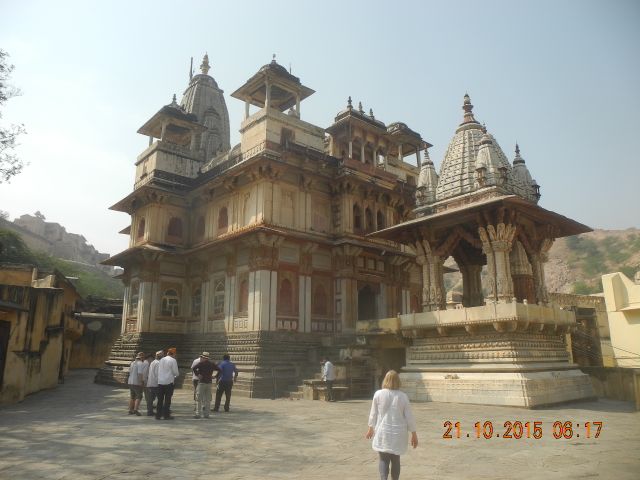
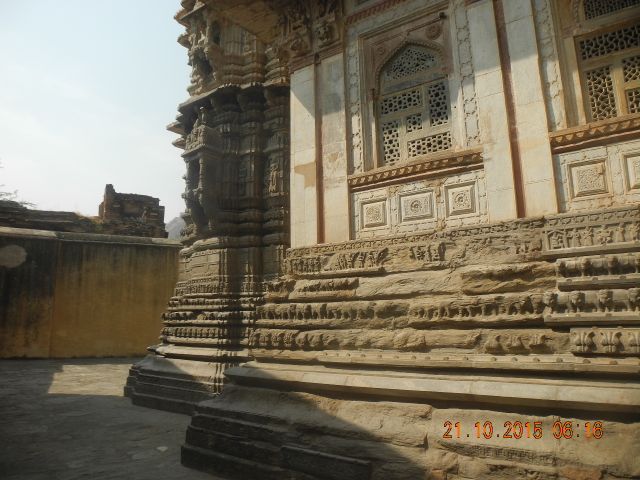
Jagat Shiromani Temple and detail of carved podium views looking south west.
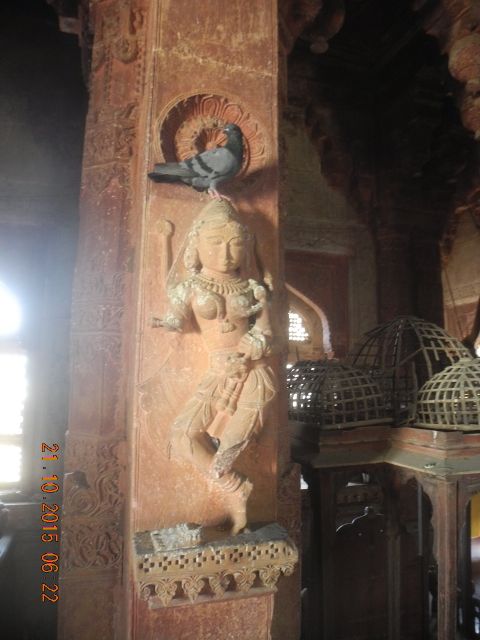
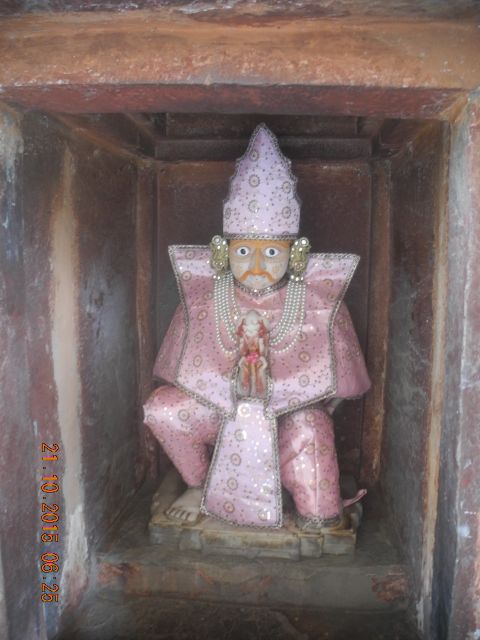
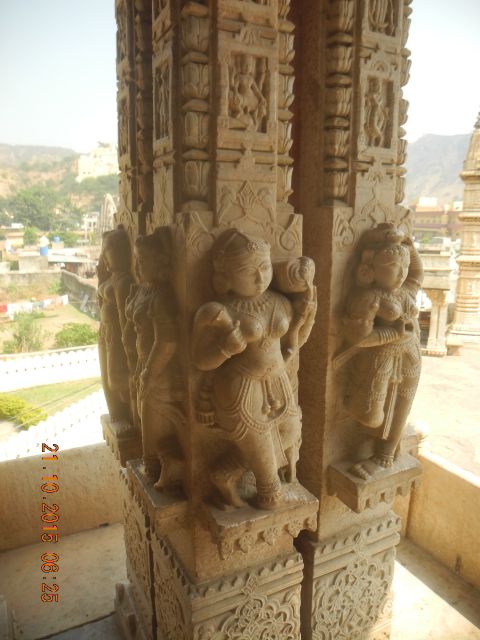
A gallery of deities and supporters.
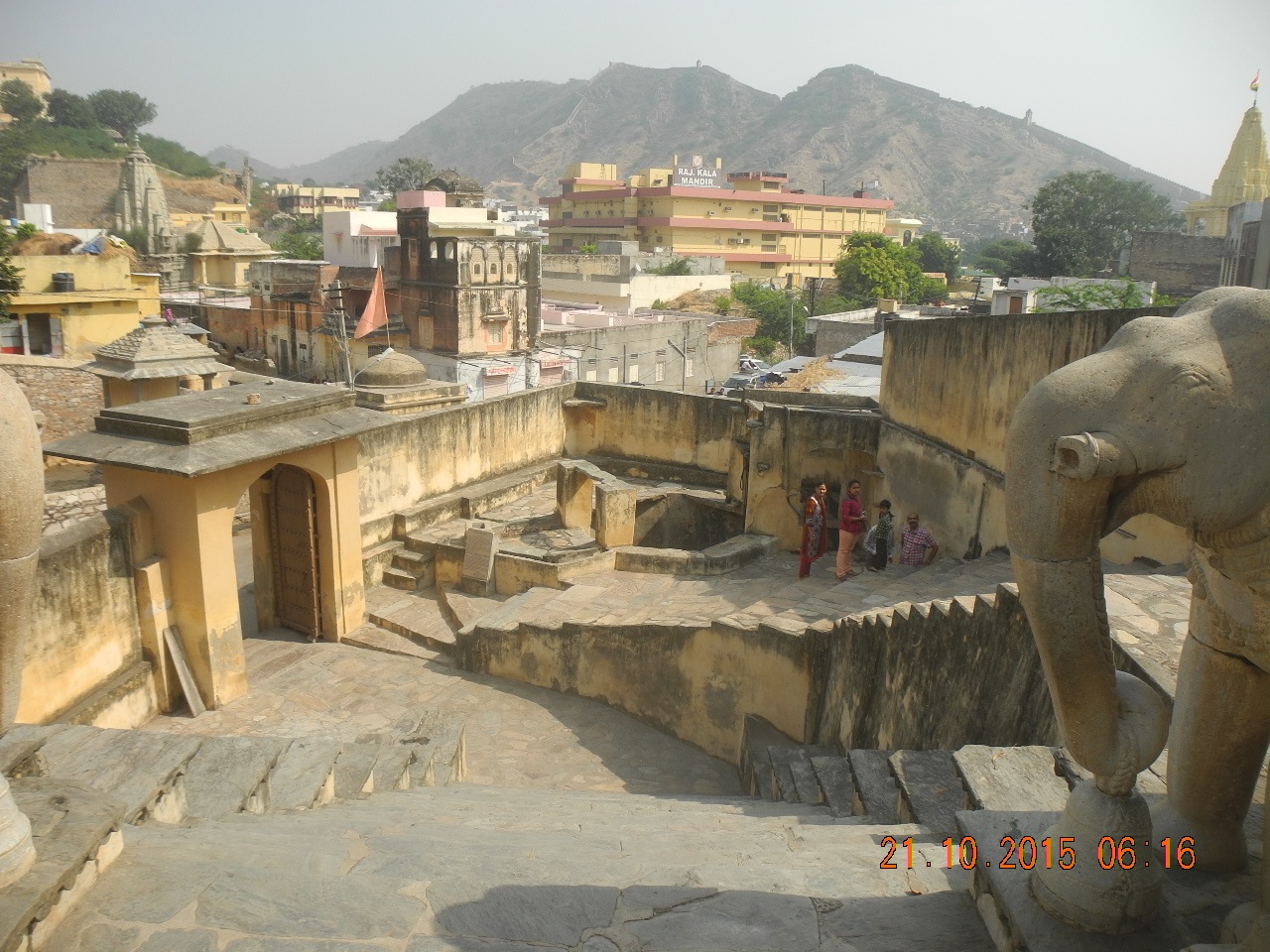
The temple precinct looking north east, entry gate and well
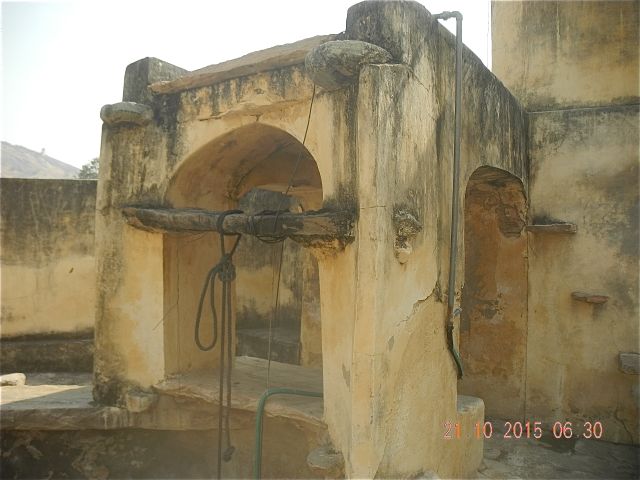
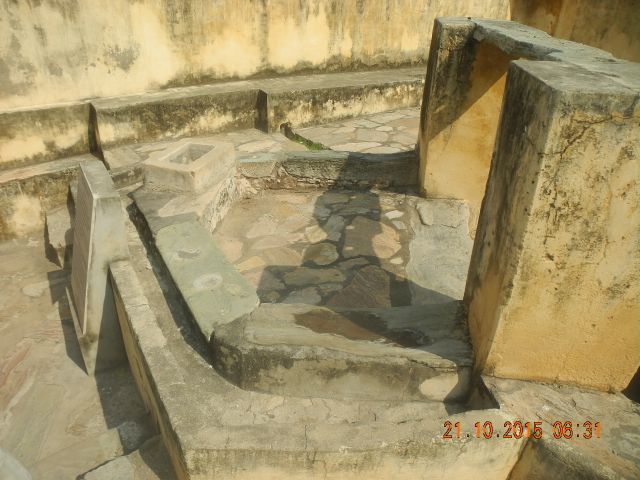
Detail of well head and tank and channels
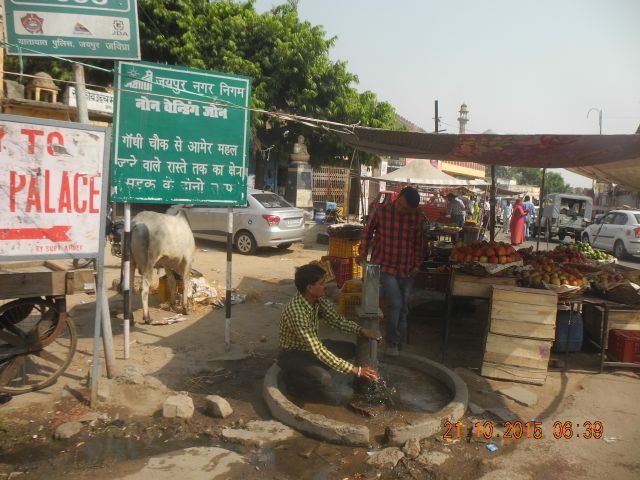
Back down in the village at the local pump, we had one in garden at Kellogg College like this.
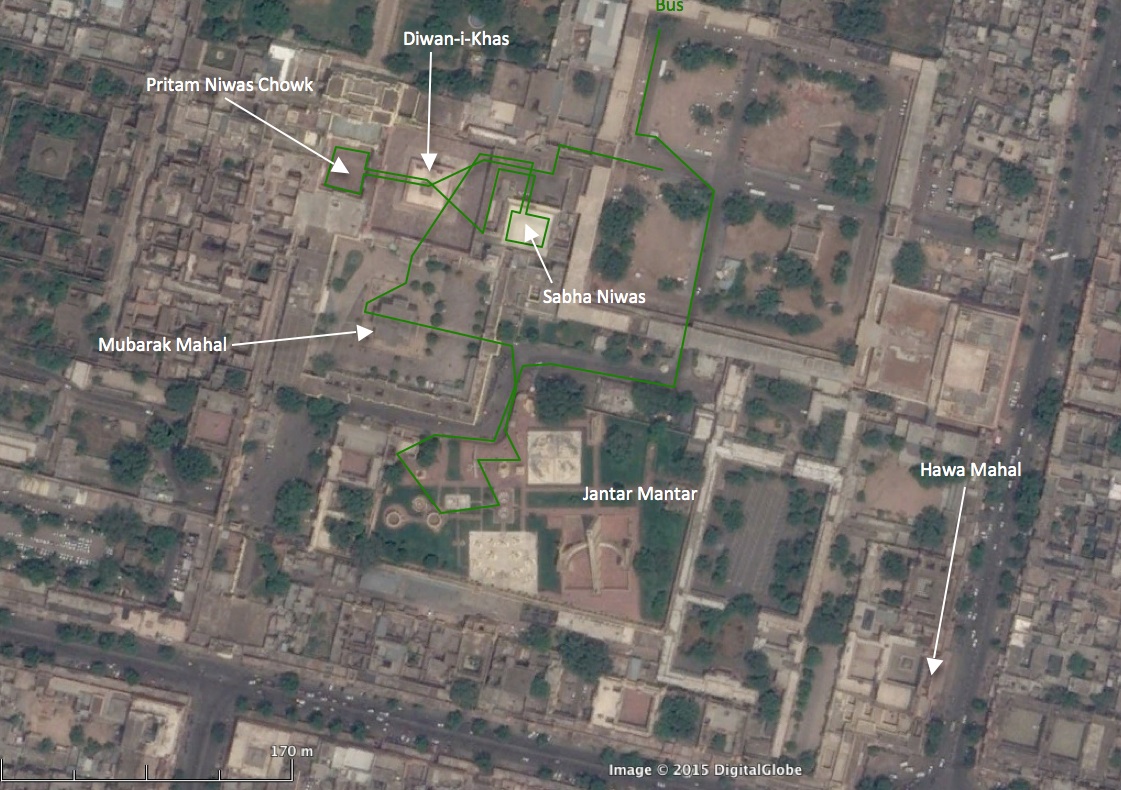
Wanderings around the City Palace, Jaipur
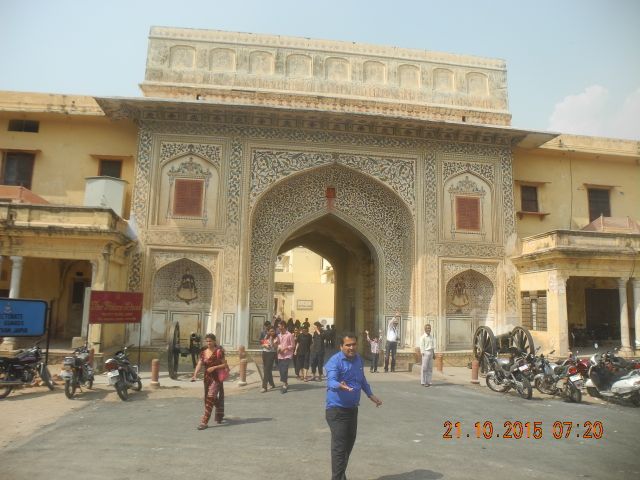
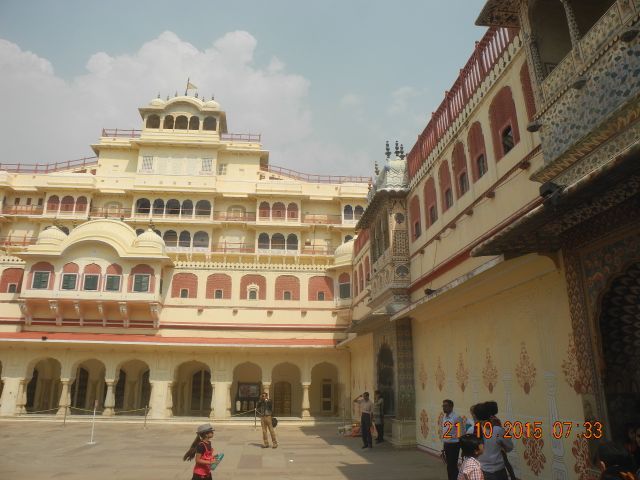
Raj leads the way through the Udaipur Gate, looking west. View of royal palace from the Pritam Niwas Chowk, looking north.
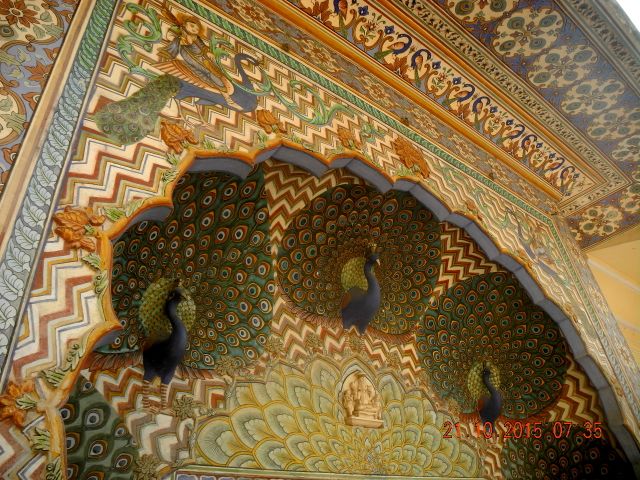
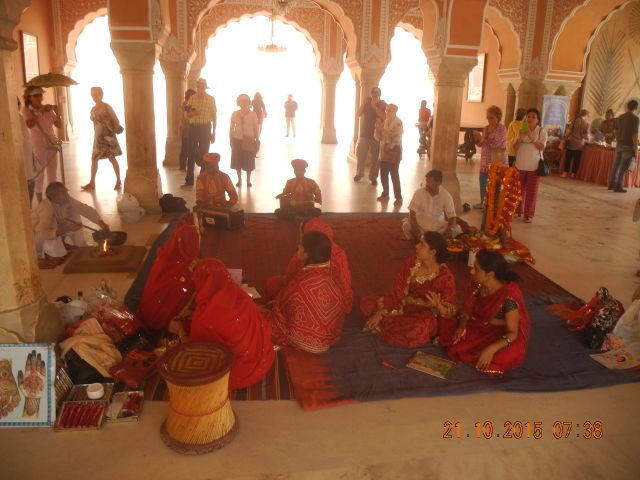
Detail of the Peacock Gate on the east side of the Pritam Niwas Chowk and a Hindu celebration underway in the Diwan-i-Khas.
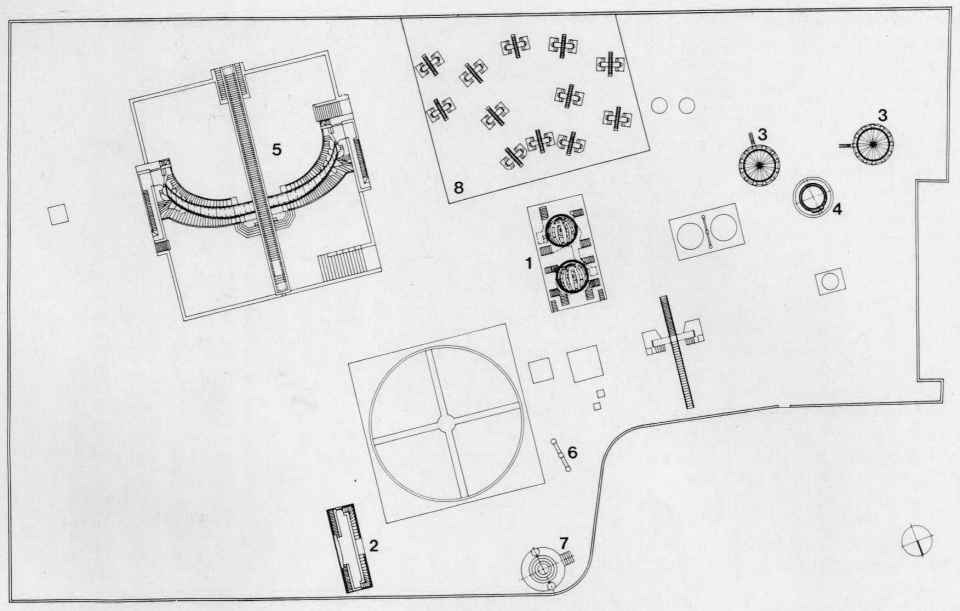
Jantar Mantar plan. (1) Jaiprakash Yantra; (2) Dakshinabhitti Yantra; (3) Ram Yantra; (4) Digmamsa Yantra, (5) Samrat Yantra; (6) Raj Yantra; (7) Unnatansha Yantra; (8) Rashivalayas Yantraa
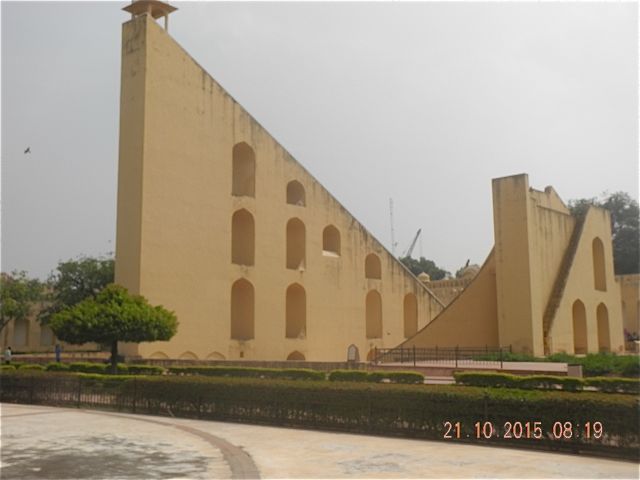
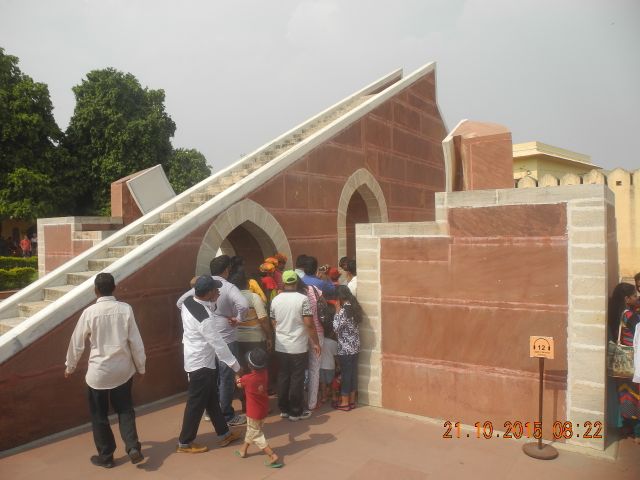
The Jantar Mantar: the spectacular 27 m high sundial the Samrat Yantra, looking south east, families gather round another sundial for an explanation.
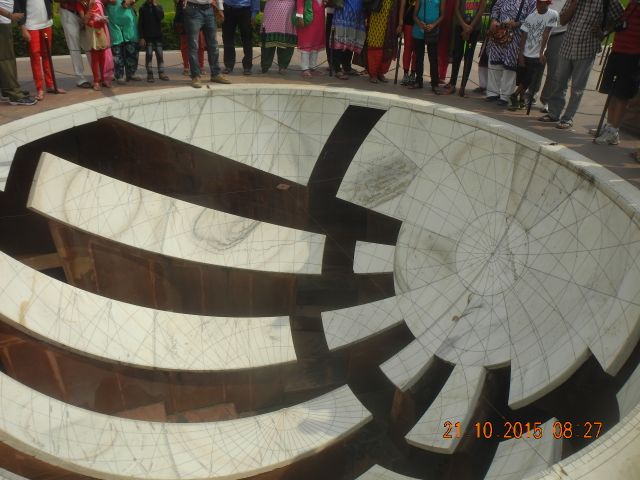
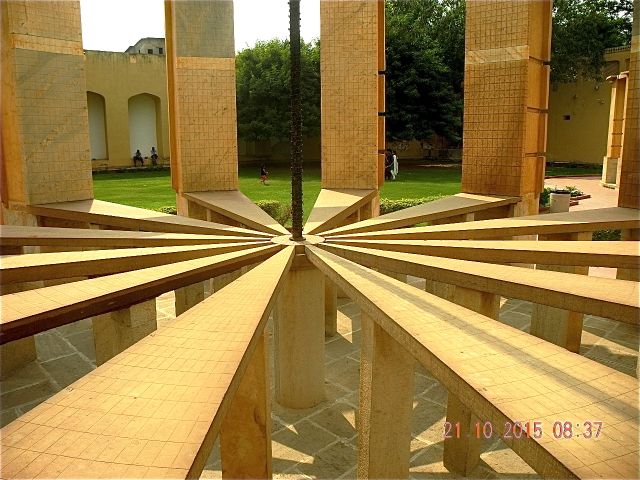
The Jaiprakash Yantra II looking north east and the interior of the Ram Yantra looking south west.
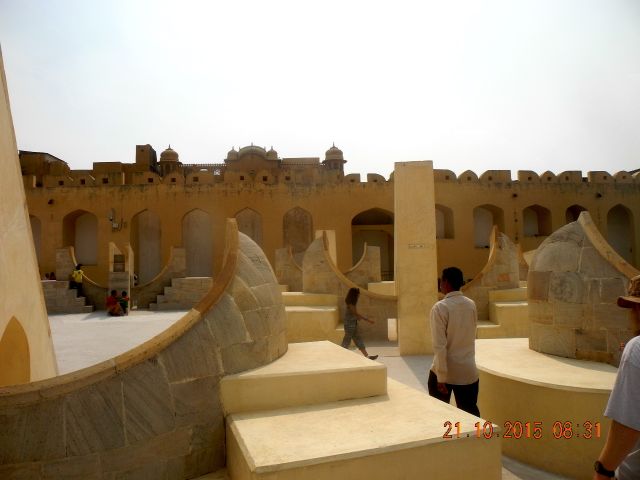
The Rashivalayas Yantraa looking south, one sundial for each sign of the zodiac.
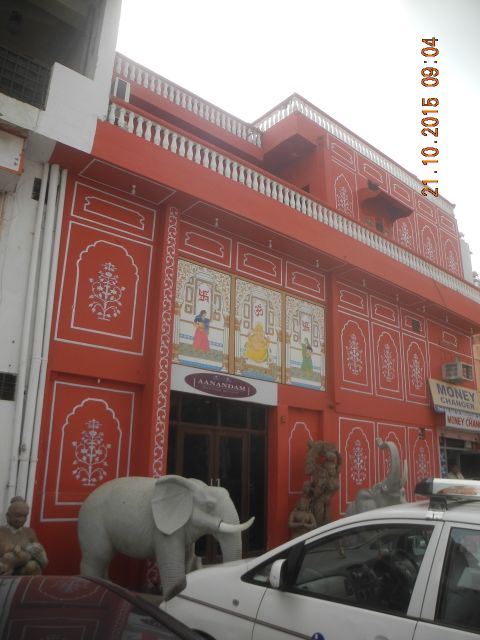
Our lunch stop in Jaipur.
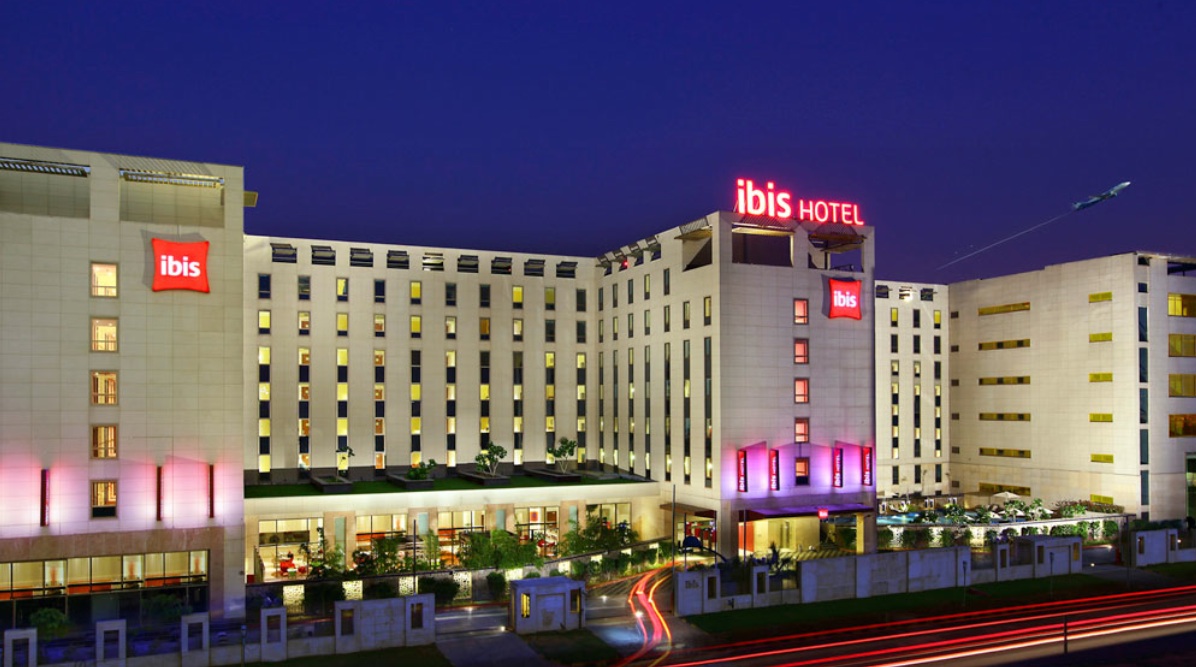
Promotional photo of the very comfortable Ibis Hotel, last stop before flying home.
After some phoning around we finally got through to someone who was both well organised and spoke sense. We discovered that our venue for the evening's performance was the Baha'i auditorium attached to the famous Baha'i Lotus Temple which was just round the corner. With this in mind we all set out to visit Old Delhi and the Red Fort or Lal Qila via the Delhi Metro. The system is fairly new and worked well from a technical point of view, the only drawbacks from my point of view is that it is hideously crowded and runs some distance underground, now I'm not too good underground or in confined spaces (people have pointed out in the past that this is a bit of a handicap for an archaeologist) so the whole thing was quite challenging. We traveled from Nehru Place to the Central Secretariat then changed lines to head on to Chandni Chowk, the station for the main shopping drag through the old town to the Red Fort. Once out of the station it took us some time to orientate ourselves and there was a certain amount of harassment from local 'guides' who had to be sent packing. Eventually with the help of map on phone and GPS we emerged onto the thronged thoroughfare for the kilometre of so walk to the fort. Once again large numbers of touts but we pressed on, obtained tickets and ended up passing through the Lahore Gate and into the fort... which was terribly disappointing: shabby, litter strewn, badly maintained, poor access and all the fountains, pools and water channels dry and dusty. The fort was built between 1639 and 1648 at the behest of the emperor Shah Jahan but was sacked by the Persians in 1739 and the British in 1857. We had a good look round and Verna had to tell them to clean up the toilets and then it was time to go. I hadn't mentioned that this was a festival weekend so the streets by now were completely solid with the press of humanity and assorted vehicles. Nevertheless we decided to take a load of cycle rickshaws back to the metro, no we didn't want them to take us round the bazaar or back to our hotel, just the metro please and once they got the message they were very good at keeping us together as they threaded their way through the all but grid locked traffic.

You can trace our route from Nehru Place to Chandni Chowk


Looking east along Chandni Chowk towards the Jain Temple and bird hospital. The open space in front of the Lahore Gate looking east.

Another unattributed plan I'm afraid but annotated by me to show what's left after the attack and destruction by the British in 1857


The barbican in front of the Lahore Gate looking south east. Chatta Chowk, constructed as a bazaar to give accommodation to the city's finest craft workers, now sells souvenirs, looking east.


One end of the series of barrack blocks built post 1857 by the British, looking north. The Naubhat Khana or Drum House looking south east.


The interior of the Diwan-i-Am or Hall of Public Audience looking north. Gardens and fountain in front of the emperor's private quarters, the Khas Mahal looking north east.


The Khas Mahal internal pool, niches and external pool views looking north east. Golden flowers or lit candles were placed in the niches which then shimmered behind a curtain of falling water, not any more.


Pavilion above the 'Stream of Paradise' the name given to the channeled water which ran through the palace, looking north east
and the Shah Burj another pavilion masking the water tower behind into which water was pumped from the Yamuna River to the east.


Interior of the Shah Burj showing armed guard and the textured ramp down which the incoming water flowed plus a view to the rear showing the top of the octagonal water tower, both looking north east.


The Hayat Bakhsh Bagh, the only surviving formal garden: The Bhadon Pavilion looking north and the Zafar Mahal of 1842 which once stood at the centre of a square pool looking north east.

Detail of the channels and small ornamental basins surrounding the central pool, looking north east.

The Red Fort

Cycle rickshaw rider on the Chandni Chowk demonstrates his strength...
Once back at the
Eros there was time for lunch and a shower then we were driven just
round the corner to the Baha'i Auditorium where we were part of a
double bill with a Taiwanese 'Bamboo' orchestra, another
extraordinarily talented group of youngsters. We followed them on and
it went very well to the point where, at the end, we got folks up to
join in with Shepherd's Away. After the show they kept the temple open
late for us so we were able to stroll though the gardens and enjoy the
tranquil atmosphere before returning to hotel for more food.
* Thanks to Rajnish Prasad for the following photographs


Performing at the Baha'i Auditorium*

Preparing for our farewell dance*.

The Lotus Temple*
SUNDAY OCTOBER 18th.
Once again the message came through, eventually, that we were to be packed and ready to go for a mid-day flight to Lucknow so we mostly had a relaxing morning then we were on our way. Once touched down in Lucknow we were greeted by the formidably well organised regional officer and an armed police guard! They lead the way as our motorcade threaded its way through Lucknow and crowds of protesting farmers with trailers full of flag waving supporters all pulled by tractors. We arrived at the Deep Palace Hotel and after a little confusion ended up being very well fed then the news went round that we needed to see what was going on in the street outside....
Once again the message came through, eventually, that we were to be packed and ready to go for a mid-day flight to Lucknow so we mostly had a relaxing morning then we were on our way. Once touched down in Lucknow we were greeted by the formidably well organised regional officer and an armed police guard! They lead the way as our motorcade threaded its way through Lucknow and crowds of protesting farmers with trailers full of flag waving supporters all pulled by tractors. We arrived at the Deep Palace Hotel and after a little confusion ended up being very well fed then the news went round that we needed to see what was going on in the street outside....


The festival of Dusshera, not sure what's being sold but here comes the procession...

.... plus elephant! (The shiny circles are the flash reflected off the dust in the air!)
MONDAY OCTOBER 19th.
We had a morning tour laid on for us, once again with armed police escort so our first port of call was the Bara Imanbara a Shi'ite assembly hall built in 1784 with an interesting interior around the large hall, we had a whistle stop tour which unfortunately did not include the step well nor the attached mosque which was closed anyway. Next we were whisked off to the Chhota Imambara another assembly hall built for the local Shia Muslims between 1837 and1842 and famed for its decor but were not allowed entry, no explanation why but there was a lot of haggling between our guide and the custodians before we sloped off. Then round the corner to the Jama Masjid, apparently a magnificent building constructed by the third Nawab of Awadh, Mohammad Ali Shah in 1423, the mosque is closed to “non-Namazis,” a euphemism for non-Muslims so we peered over the fence before moving on. Finally we landed up at the former British Residency famed for its siege during the Indian Mutiny of 1857where they did let us in. The ruins were preserved pretty well as abandoned after the relief of Lucknow although obviously there has been considerable tidying up and consolidation since then. Like many historic sites in India it is popular with young couples seeking a little privacy, this makes poking around a ticklish business at times. Back to the hotel for a late lunch then on the the Sant Gadgeji Maharaj Auditorium. Our performance had to be extended to over an hour that evening as we were the only act on the bill, hard work but I think we pulled it off. Later that evening after dinner we made another sortie onto the streets to pick up on all the festival latest.
We had a morning tour laid on for us, once again with armed police escort so our first port of call was the Bara Imanbara a Shi'ite assembly hall built in 1784 with an interesting interior around the large hall, we had a whistle stop tour which unfortunately did not include the step well nor the attached mosque which was closed anyway. Next we were whisked off to the Chhota Imambara another assembly hall built for the local Shia Muslims between 1837 and1842 and famed for its decor but were not allowed entry, no explanation why but there was a lot of haggling between our guide and the custodians before we sloped off. Then round the corner to the Jama Masjid, apparently a magnificent building constructed by the third Nawab of Awadh, Mohammad Ali Shah in 1423, the mosque is closed to “non-Namazis,” a euphemism for non-Muslims so we peered over the fence before moving on. Finally we landed up at the former British Residency famed for its siege during the Indian Mutiny of 1857where they did let us in. The ruins were preserved pretty well as abandoned after the relief of Lucknow although obviously there has been considerable tidying up and consolidation since then. Like many historic sites in India it is popular with young couples seeking a little privacy, this makes poking around a ticklish business at times. Back to the hotel for a late lunch then on the the Sant Gadgeji Maharaj Auditorium. Our performance had to be extended to over an hour that evening as we were the only act on the bill, hard work but I think we pulled it off. Later that evening after dinner we made another sortie onto the streets to pick up on all the festival latest.

The Deep Palace Hotel.


The mosque at Bara Imanbara looking north west with view of approaching pilgrims.

The step well, not my photo unfortunately.


Outside the Bara Imanbara we were asked to line up and have our photos taken, always keen to oblige, and here is Pete hitching a ride with our police escort, brave man.


The Satkhanda a watch tower cum observatory from the late 1830s looking north and the entry front of the Jama Masjid looking south east.

The Lucknow Residency complex at the time of the siege in 1857.


The Bailey Guard Gate from the east. The treasury from the south, note damage from cannon balls.


The Residency from the south west. Well and water channels from east on edge of the lawn south of museum

Another well plus channels and circular tanks east of Dr. Taylor's House


Photo of the Residency immediately after the siege plus same view looking north west in 2015.


Back on the street that evening, Dusshera rituals underway and the boy band in waiting.
TUESDAY OCTOBER 20th.
An early start and escorted back to the airport for the return flight to Delhi and collected from there by our very own tour company for the six and a half hour drive to Jaipur. Rather a depressing trip with endless little roadside settlements, some of the buildings having been literally cut in half by the process of widening the road, rather extraordinarily many of the 'half houses' are still inhabited as the traffic rumbles part outside. Some of the most distressing sights and signs of utter poverty greeted us on the last 20 kilometres coming into town, so bad that even taking photographs felt wrong. Once we got there we weren't good for much more than checking in and eating at our hotel the Dera Rawatsar.
An early start and escorted back to the airport for the return flight to Delhi and collected from there by our very own tour company for the six and a half hour drive to Jaipur. Rather a depressing trip with endless little roadside settlements, some of the buildings having been literally cut in half by the process of widening the road, rather extraordinarily many of the 'half houses' are still inhabited as the traffic rumbles part outside. Some of the most distressing sights and signs of utter poverty greeted us on the last 20 kilometres coming into town, so bad that even taking photographs felt wrong. Once we got there we weren't good for much more than checking in and eating at our hotel the Dera Rawatsar.


Truncated accommodation en route to Jaipur. A stone cutters workshop with mounds of stone chippings.


Water point on the outskirts of Jaipur and the first of the many gates we saw to the planned city.


Two views of the Dera Rawatsar: the internal courtyard and pool.
WEDNESDAY OCTOBER 21st.
Out with our amiable guide Raj for a sight-seeing tour pausing briefly outside the Hawa Mahal to take photos and fend off fan sellers and the like then on to the town of Amber. An elephant ride had been scheduled which some members took advantage of, others were less sure but then there was the excitement of a jeep ride up the hill to the entrance to Amber Fort, a massive hill top palace built as a Rajput stronghold occupied between 1037 and 1728 by the Kachchwaha clan until they moved to Jaipur, after having built it first. Something of a gauntlet of sellers of native fiddles, puppets, post cards, turbans and fridge magnets... fridge magnets? Raj had obtained the services of a guide who did a good job of taking us round and encouraging us to peer into assorted odd corners. When the trip was over our guide, having heard our express wish to visit a Hindu temple lead us down a track from the fort to the rather spectacular Jagat Shiromani Temple erected between 1599 to 1608 by one Man Singh after the death of his son in battle. We were blessed by the attendant holy man before returning to our jeeps and coach.
Out with our amiable guide Raj for a sight-seeing tour pausing briefly outside the Hawa Mahal to take photos and fend off fan sellers and the like then on to the town of Amber. An elephant ride had been scheduled which some members took advantage of, others were less sure but then there was the excitement of a jeep ride up the hill to the entrance to Amber Fort, a massive hill top palace built as a Rajput stronghold occupied between 1037 and 1728 by the Kachchwaha clan until they moved to Jaipur, after having built it first. Something of a gauntlet of sellers of native fiddles, puppets, post cards, turbans and fridge magnets... fridge magnets? Raj had obtained the services of a guide who did a good job of taking us round and encouraging us to peer into assorted odd corners. When the trip was over our guide, having heard our express wish to visit a Hindu temple lead us down a track from the fort to the rather spectacular Jagat Shiromani Temple erected between 1599 to 1608 by one Man Singh after the death of his son in battle. We were blessed by the attendant holy man before returning to our jeeps and coach.

It had to be done, the inevitable photo of the hugely impressive Hawa Mahal or Palace of the Winds, view looking south west.


Approaching Amber: looking north towards the palace across the lake and associated formal gardens below the palace.


Hands up for an elephant ride. View of the Jaigarh Fort above the palace looking north.

The area of the Amber Fort.


Amber Fort: courtyard with the Diwan-i-Am or Hall of Public Audience of 1639 looking east. Below the courtyard is a large cistern, this is one of the hatches that gives access to it.

The magnificent painted gateway known at the Ganesh Pole view looking west.


Rather washed out views of the Amber Fort Gardens and dam and the famous Kesar Kyari Bagh or Saffron Garden sitting in the Maotha Lake, both views looking more or less south and so into the sun.

Sunken bath within the hammam with seating for four.

Up to the next level, the gardens sandwiched between the Sukh Mahal and the Sheesh Mahal. view looking west.


Basin and channel leading into the garden from the Sheesh Mahal, view looking north west plus tourists enjoying the Sheesh Mahal.


Waterworks designed to cool within the Sukh Mahal: textured ramp and channel looking north west and further ramp and steps down to the garden looking south east.


More details of facilities: the small bathing pool within the women's quarters and the toilets looking remarkably Roman, form follows function I guess.

The pillared baradari within the courtyard of the earlier Palace of Man Singh I adapted as the women's quarters, view looking west.


Jagat Shiromani Temple and detail of carved podium views looking south west.



A gallery of deities and supporters.

The temple precinct looking north east, entry gate and well


Detail of well head and tank and channels

Back down in the village at the local pump, we had one in garden at Kellogg College like this.
The coach then took us back to Jaipur with a brief stop on the rather grubby promenade over looking Man Sagar Lake
with a view of the Jal Mahal. Unfortunately the light was all wrong for
a decent photograph but there was an interesting view of a distant dam.
Onward into town once more and were dropped off outside the Udaipol
Gate to visit the Jaipur City Palace. We wandered round but didn't pay
a great deal of attention to the various museums on offer before
wandering out again to take a look at the famous astronomic /
astrological observatory the Jantar Mantar.
truly fascinating with an extraordinary guide who was casting
horoscopes on the fly, most impressive. Back then to the bus, lunch at
the Aanandam Restaurant the the long, long journey back to Delhi
enlivened by some creative driving to get past assorted traffic jams
and the provision of a round of beers thanks to Raj just before our
arrival at the suitably westernized Ibis Hotel, all ready to fly out the next morning.

Wanderings around the City Palace, Jaipur


Raj leads the way through the Udaipur Gate, looking west. View of royal palace from the Pritam Niwas Chowk, looking north.


Detail of the Peacock Gate on the east side of the Pritam Niwas Chowk and a Hindu celebration underway in the Diwan-i-Khas.

Jantar Mantar plan. (1) Jaiprakash Yantra; (2) Dakshinabhitti Yantra; (3) Ram Yantra; (4) Digmamsa Yantra, (5) Samrat Yantra; (6) Raj Yantra; (7) Unnatansha Yantra; (8) Rashivalayas Yantraa


The Jantar Mantar: the spectacular 27 m high sundial the Samrat Yantra, looking south east, families gather round another sundial for an explanation.


The Jaiprakash Yantra II looking north east and the interior of the Ram Yantra looking south west.

The Rashivalayas Yantraa looking south, one sundial for each sign of the zodiac.

Our lunch stop in Jaipur.

Promotional photo of the very comfortable Ibis Hotel, last stop before flying home.
So, what to make of it all? Delhi is an astonishing place which one observes with a kind of fascinated horror, at first one
is simply stunned by the noise, the heat, the crowds and the dirt, then
out of the chaos one starts to pick out details which can be
alternatively glorious then ghastly. A growing sense of disgust at
some of the sights unfolding on the streets is replaced by a feeling of
shame, then numbness, then a kind of weary acceptance of the continuing
parade of poverty with its consequent filth and squalor. It seems to
me that two things are ruining India at present: concrete and plastic,
the first has enabled shoddy construction to take place at high speed
with the resulting accumulation of debris everywhere whilst the second
contributes to a litter problem of literally mountainous proportions.
There is clearly a rhetoric in the press that the country is a go ahead
kind of place pressing forward with all the latest technology and
leaving behind its past, whether this view contributes to a general
neglect of historic sites or the problems are more of an economic
nature I can't say but the general condition of most of the monuments
we visited was poor, badly maintained, overgrown and strewn with
litter. The main exception to this was Humayun's Tomb in south
Delhi which has recently been heavily invested in as part of its status
as a world heritage monument, I wonder if in 10 years time it will be a
shabby and neglected as the Red Fort (Lal Qila) is today. Exploring the
archaeology of Delhi is not for the faint-hearted: expect harassment
from touts and would be guides, be prepared for packs of dogs, biting
monkeys and semi-wild pigs, carry water in copious amounts and be ready
to wade through litter and other less savoury deposits. Would I go back? Of course!